Wondering what it’s like in Florence in winter? Well, it’s a little chilly, but the air is crisp, the crowds are mild, all museums are open, guided tours run with small groups, restaurants always have tables available, and to top it all off, prices at many establishments are considerably lower than during the high seasons.
Why Visit Florence in Winter
Florence is a spellbinding city. It is essentially a 505-hectare open-air fine art museum where people have lived for two thousand years.
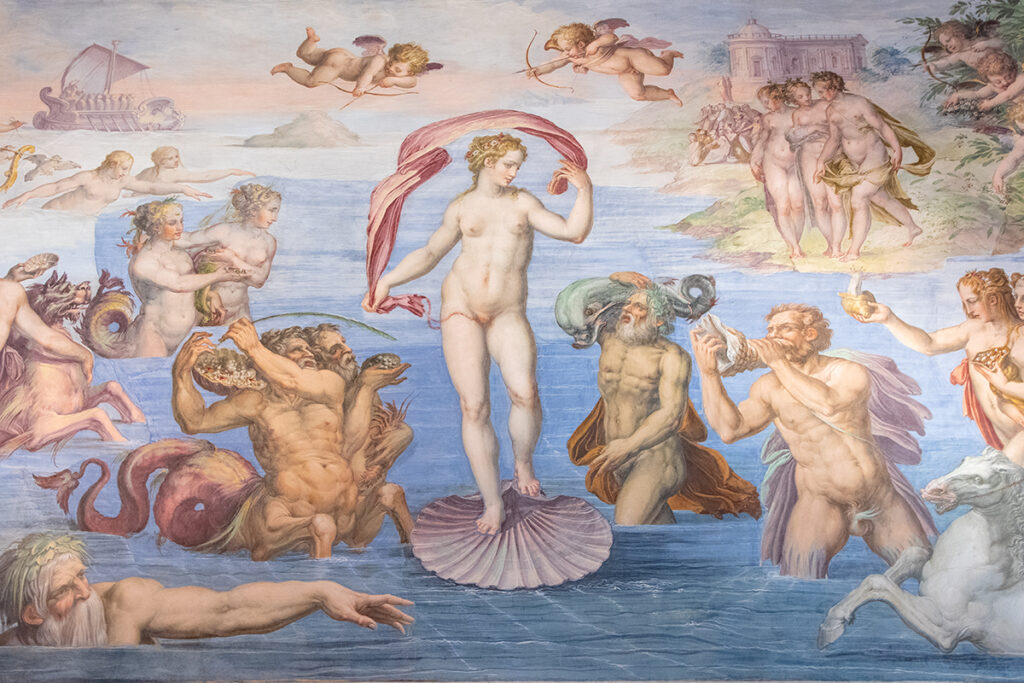
Established by Julius Cesar in 59 BC, the city began as the Roman village of Florentia. A millennium and a half later, it became the cradle of the Renaissance, and today it is one of the most popular tourist destinations in the world. And one of the most crowded ones.
In 2018, just before the pandemic, 27.7 million people visited Florence. The main tourist area of Florence is about 5 square kilometres. This gives you an idea of just how crowded it gets in Florence during the peak season (spring-summer-autumn).
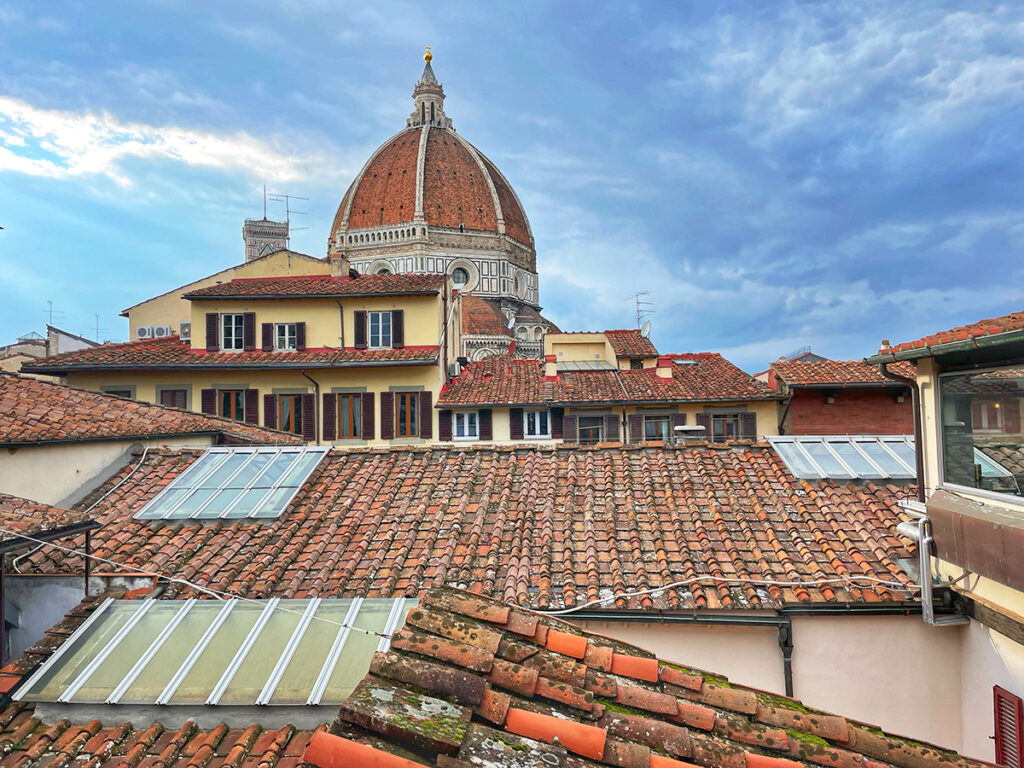
But in winter (outside of the Christmas season), you can find yourself standing in front of Botticelli’s Birth of Venus completely alone. Or stroll across Ponte Vecchio to the Oltrarno neighbourhood and lose yourself among its narrow cobbled streets with only local people for company. Plus, hotel and restaurant prices are lower in winter, so it’s an excellent time for visiting Florence on a budget.
It is still a good idea to pre-book your museum visits well in advance, but you will not face the epic queues of the summer season. And if you are a keen photographer, you’ll love the streets devoid of crowds, especially early in the morning.
Weather in Florence in winter
Surrounded by the Mediterranean Sea, Italy enjoys a mild climate. Florence in winter is not quite as warm as Rome, but that simply means that you need to dress for the weather. In December and January, the daytime temperatures are around 10 degrees and in February, around 12 degrees. Nights do get cooler, dropping to 1-2 degrees in December-January and 3 degrees in February.
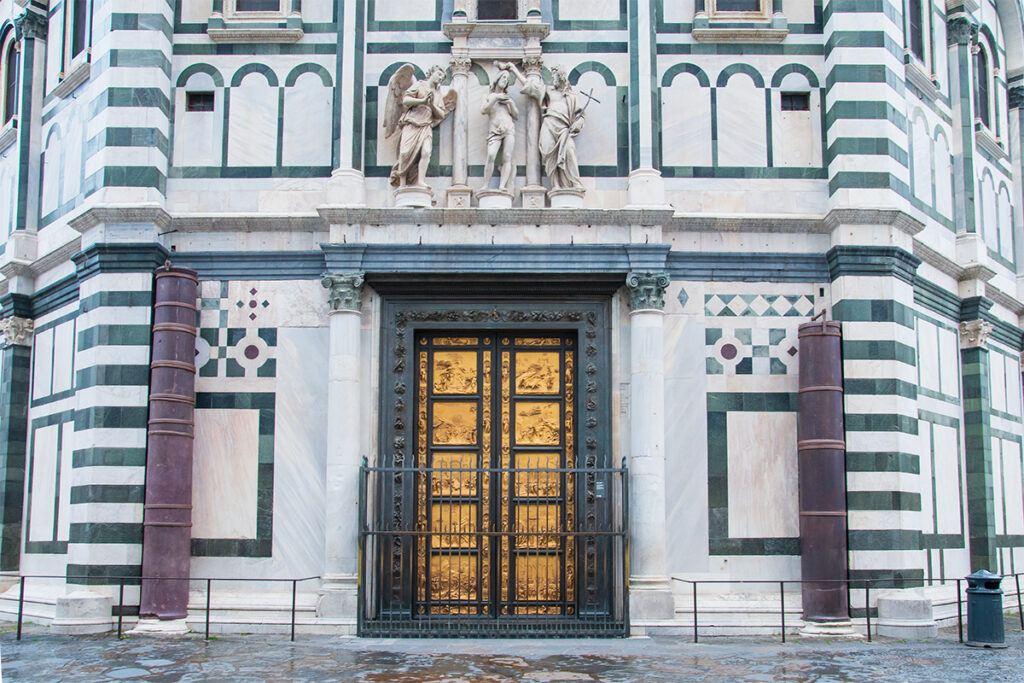
You do get rainy weather in Florence in winter, but even on rainy days, it doesn’t usually rain all day long, even when the forecast says it will. On average, you might get two or three days of rain during the week. And if you are staying in the old town of Florence, all the main attractions are only a short walk away, so you won’t be walking far in the rain.
You will also appreciate central heating in Florence in winter. Coming from Australia, I certainly did. Hotels, indoor attractions, restaurants, and even trains are all heated in Italy.
Is Florence in Winter Worth it?
A resounding yes! Winter is one of the best times to visit Florence. It is the only time of the year to experience Florence like a local, to enjoy exploring the city and see its magnificent art without being swallowed up by the sea of tourist traffic.
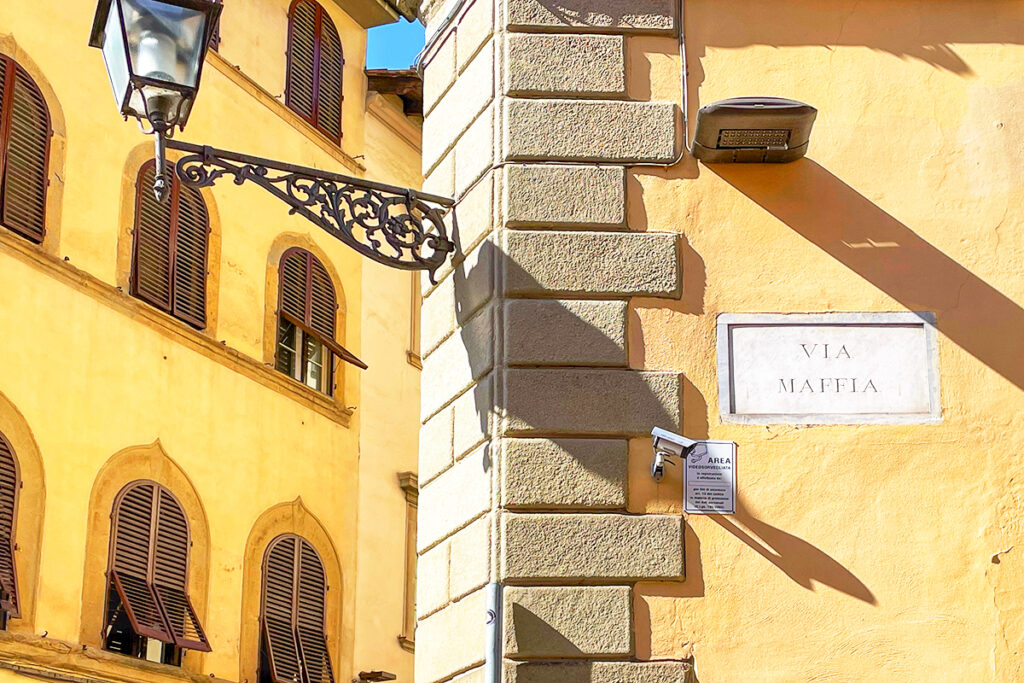
The city’s palaces, churches, and museums are all open and first thing in the morning you might just have them to yourself. The city is still buzzing with tourists, but it feels more like a busy Sunday than an amusement park of the peak season. So if you want to feel the essence of Florence, winter is the best time to visit.
Things to Do in Florence in Winter
Your winter itinerary in Florence won’t be much different to any other season. You might be able to see more in winter since you won’t be delayed by long queues and will not have to navigate the crowds.
On the other hand, the days are shorter. So you’ll want to plan your museum visits for late afternoon and enjoy the outdoors during the sunny hours.
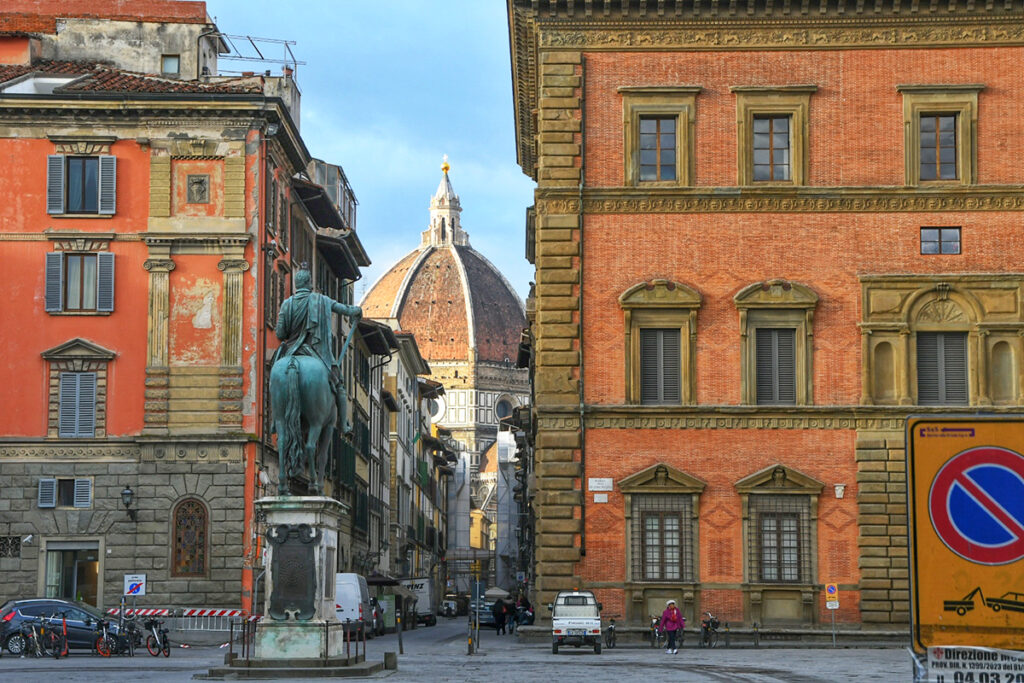
It is possible to see the best of Florence in 2 days (even in 1 day, if you have to) if you don’t mind packing your days full. 3 days in Florence will let you explore some attractions slightly further from the centre, like the beautiful and tranquil San Marco Monastery, Santa Maria Novella church, or the Pitti Palace and Brancacci Chapel in Oltrarno.
If you have more time, you can explore the city at a more leisurely pace and perhaps follow some of the themed walking itineraries, like Medici Florence, Dante Florence, Da Vinci’s Florence, or even take a trip to Vinci to walk in the footsteps of the Renaissance genius. Winter is generally a good time to take day trips from Florence. You can enjoy cities like Siena, Pisa, or San Gimignano without the crowds. You could even stay at one of the wine hotels in Tuscany in winter – the countryside is still lush and green.
If this is your first visit to Florence, at the very minimum, try to visit the city’s most important sites. All the places listed below are within easy walking distance from Piazza del Duomo. The furthest walk is the two sunset viewpoints, Piazza Michelangelo and San Miniato al Monte Abbey, both a 25-30 min stroll with about 10 min of steep uphill section at the end.
Duomo and Piazza del Duomo
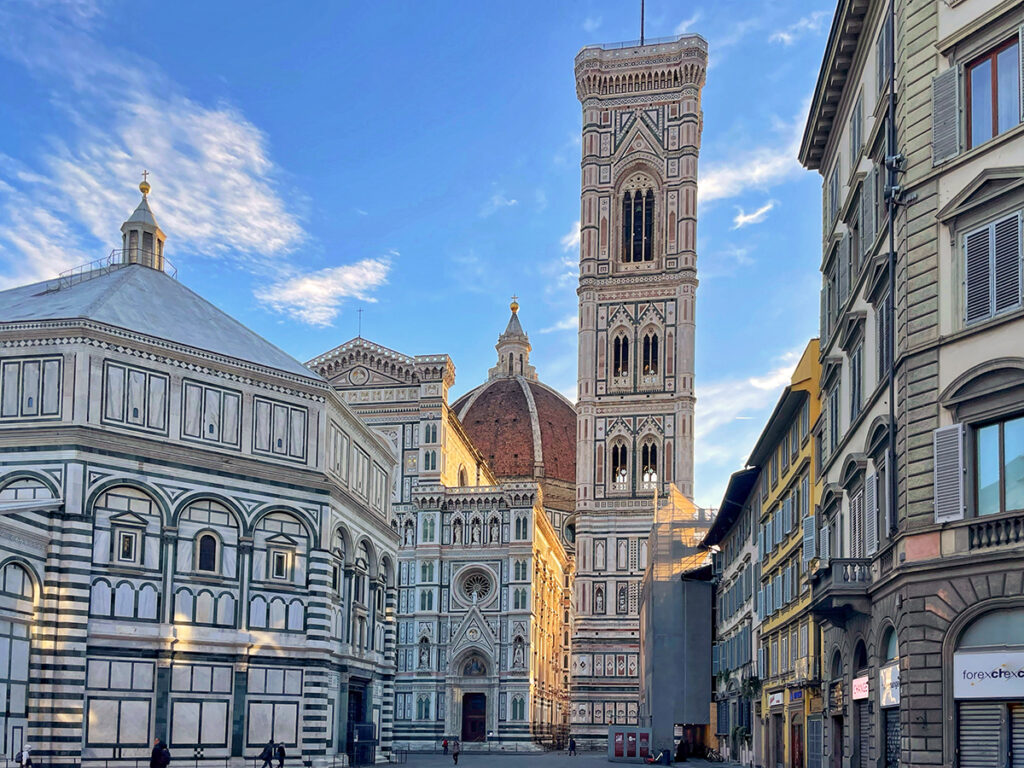
- Time to visit: 1-3 hrs
- Tickets: Duomo website
- Best tour: Skip-the-line entry and dome climb
Piazza del Duomo is defined by Florence’s most iconic landmarks – the Duomo Complex made up of five monuments: the Cathedral of Santa Maria del Fiore (or Simply Duomo), Brunelleschi’s Dome, Giotto’s Campanile (bell tower), the Baptistery of San Giovanni, the Crypt of Santa Reparata and the Opera Museum (where most of the original artworks from the complex are safeguarded).
The Baptistery is the oldest building in the square (and one of the oldest in Florence), and the first one to be decorated in the iconic pattern of white, red, and green marble.
Florence Cathedral (Duomo)
The magnificent Florence Cathedral (Cattedrale di Santa Maria del Fiore), or simply the Duomo, is one of the most recognizable buildings in the world. Designed in 1296 by Arnolfo di Cambio, the cathedral took over a century to build, and for a long time, it stood with a giant hole in its roof until Filippo Brunelleschi came along and, with support from Cosimo di Medici designed his ingenious dome, the largest ever built at the time, in 1456.
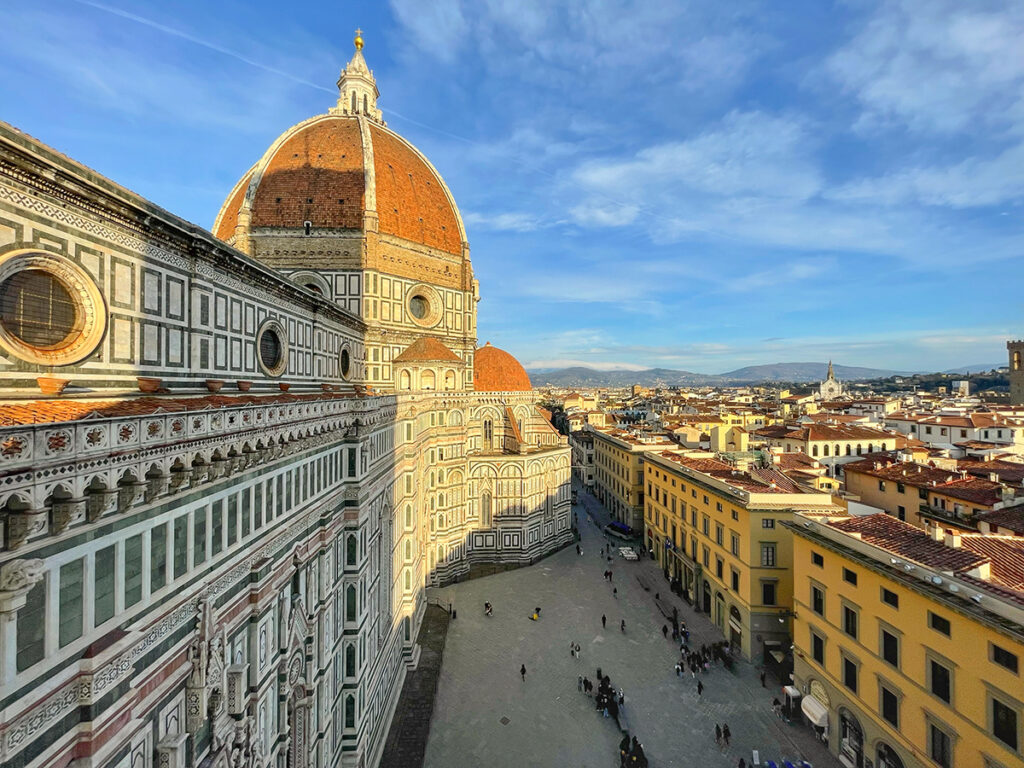
To properly appreciate the Duomo, you should take an organized tour to climb the famous dome for 360-degree views of Florence, visit the roof terrace, and get up close to Vasari’s monumental frescos of The Last Judgement from the two wrap-around balconies running along the dome’s ceiling.
The best tour is the one that offers exclusive access to the Roof Terrace. That’s the tour I took, and there were just five of us in the group. Apart from a brief course on art history, a visit to the Cathedral, the Dome climb and a visit to the Opera del Duomo museum, where you can see the original Ghiberti’s Gates of Paradise, this tour also gives you exclusive access to the Duomo Terraces.
The terraces are an amazing hidden gem in Florence that can only be visited on an organized tour. Your group will be the only people on the terrace, accompanied by a security guard who will unlock the door.
From the terraces, you get fantastic views of Florence and unique views of the Duomo’s roof. There are even some centuries-old cat prints to spot on the roof tiles.
If you prefer to explore independently, the Campanile, the Baptistery, and Opera del Duomo can be visited with timed entry tickets, which lets you avoid the hustle of queuing up. But the cathedral is free to enter, so there are no skip-the-line tickets for it. And the queues are long. Even in winter, be prepared to line up for at least 30 minutes.
Giotto’s Campanile
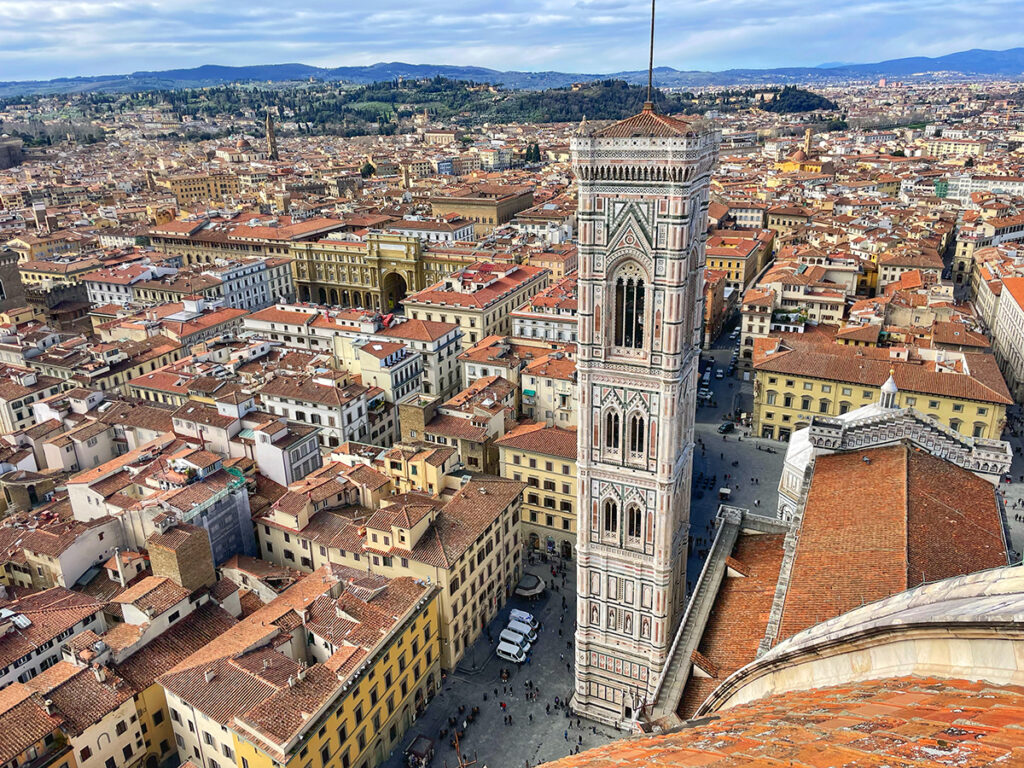
Giotto’s Campanile is the finest example of gothic architecture in Florence from the 1300s. Unlike most bell towers, Giotto’s campanile is not attached to the cathedral but stands beside it, rising almost 85 meters towards the sky.
The exterior of the campanile is decorated with 16 life-size statutes (some carved by Donatello) placed in various niches. Of course, today, the sculptures are replicas, the original works are kept at the Opera del Duomo museum.
If you did the Duomo tour, your ticket will also give you access to the climb of Campanile. If you don’t mind another 418 stairs, do climb to the top for a fantastic view of the Duomo dome. The viewing platform has an unfortunate protective wire mesh, but you can take photos through it with your phone.
The Baptistry & the Gates of Paradise
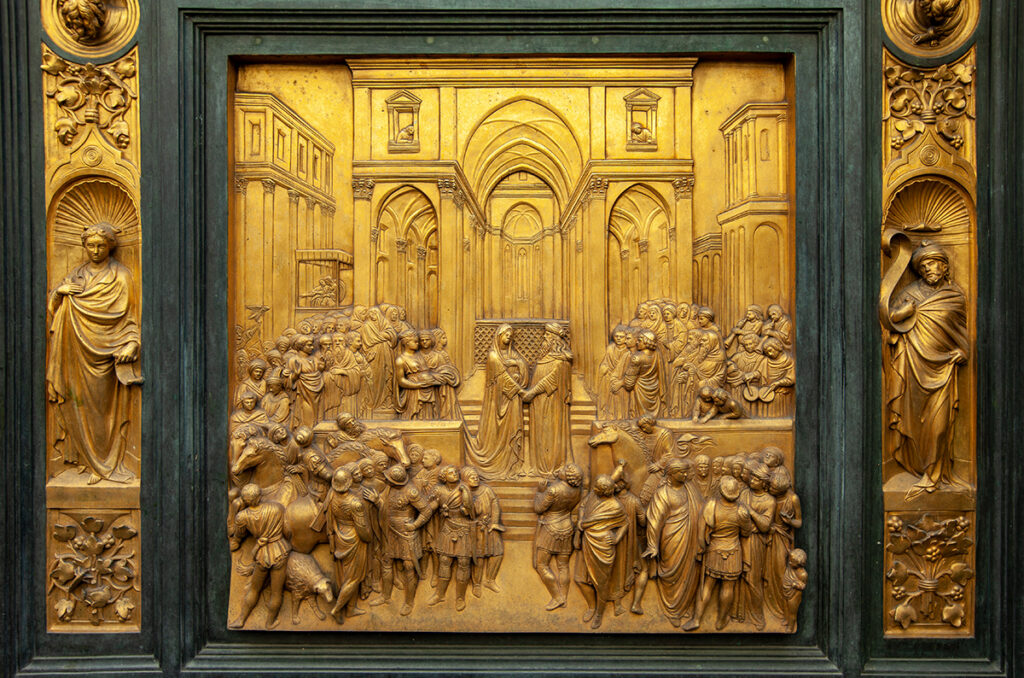
The most extraordinary features of the Baptistry are its bronze doors. The world-famous Gates of Paradise by Lorenzo Ghiberti may have begun the Renaissance. To fully appreciate The Gates of Paradise, first, have a look at Ghiberti’s earlier gates on the north side of the Baptistry. They are beautiful but in a medieval kind of way, with flat figures in stiff postures.
Then walk to the Gates of Paradise (they face the cathedral), and you will see how the scenes on the panels appear 3-dimensional, full of movement, emotion, and realism. When Michelangelo saw Ghiberti’s new gates, he proclaimed them as beautiful as The Gates of Paradise.
Inside the Baptistery, you’ll find spectacular Byzantine mosaics decorating the ceiling and the monumental tomb of Antipope John XXIII by Donatello.
Tip: if you feel like a coffee break at a cafe on Piazzo del Duomo, make sure to check the prices. Often there are two sets of prices: one for drinking your coffee standing up and one for sitting at a table. The table prices can be as much as 10 times higher than the takeaway prices. The one cafe that doesn’t charge the table surcharge is the Opera del Duomo cafe. Don’t worry, you don’t need a ticket to the museum to enter the cafe. And there are indoor and outdoor tables.
Uffizi Gallery
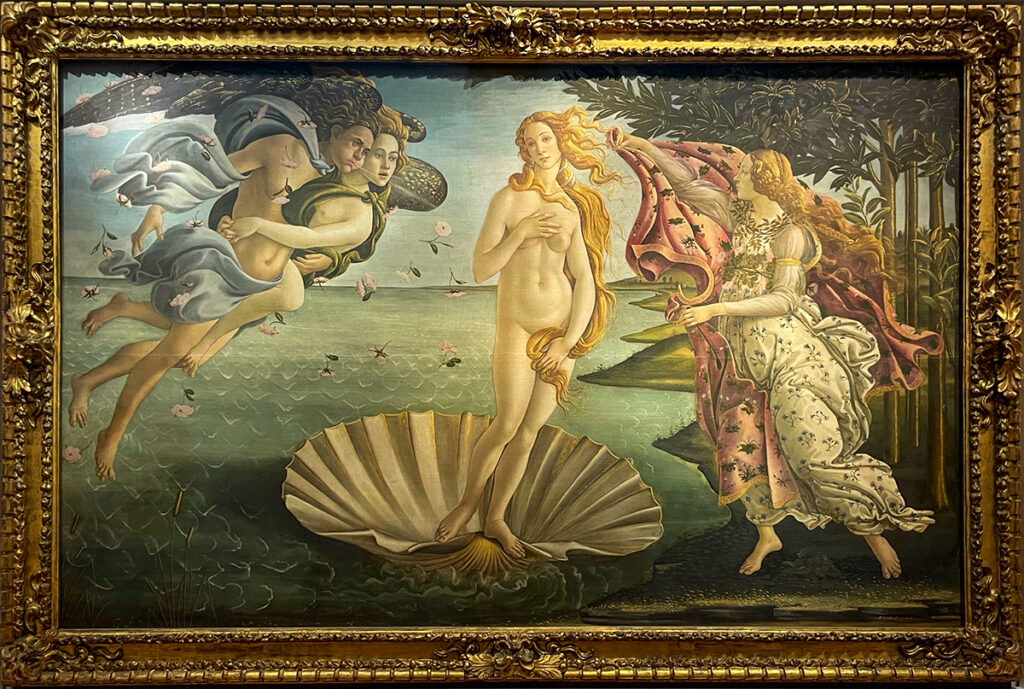
- Time to visit: 1-3 hours
- Tickets: Official Uffizi website
- Priority tickets: Priority Escorted entry
Uffizi Gallery is a true art lover’s paradise. The museum houses some of the world’s most iconic paintings, sculptures, and other art forms. Works by Botticelli, da Vinci, Rafael, Michelangelo and Caravaggio are just a few of the highlights. The museum’s art collection is immense.
If you’re visiting Uffizi Gallery for the first time, consider taking a guided tour. The museum is vast, and it’s easy to get lost in the sea of art. A guided tour will ensure that you see all of the must-see pieces, as well as provide context and background information on each piece. And if you have any questions, a tour is a great way to have them answered.
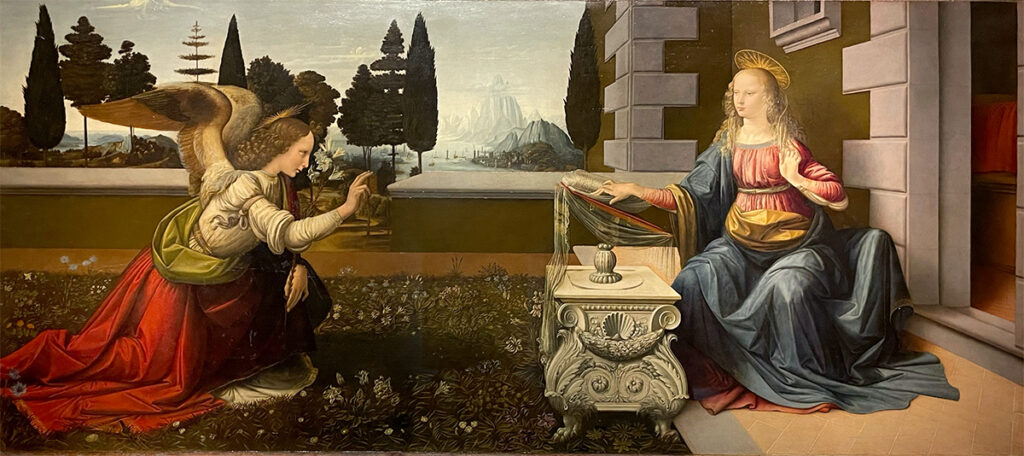
If you are looking for a quick, independent visit, here is what not to miss. Upstairs, the rooms are arranged chronologically, from medieval art to the Renaissance.
Towards the end of the hall, you’ll find Botticelli’s Birth of Venus and The Allegory of Spring, da Vinci’s Annunciation, Michelangelo’s Doni Tondo, and Rafael’s Madonna of the Goldfinch.
Downstairs, don’t miss a series of portraits of the most well-known Medici family members, including Lorenzo the Magnificent and Cozimo the Elder, in the Room of the Dynasties. And Caravaggio’s Medusa shield.
And, if visiting independently, make sure to book your tickets in advance and to join the correct queue on the day (you’ll need to redeem your tickets first). If you plan to visit Pitti Palace and Boboli Gardens, the most economical option is a combined ticket for Uffizi Gallery, Pitti Palace, and Boboli Gardens. And if you would like a chance to be the only visitor in your favourite gallery room at Uffizi, opt for an 8.15 am entry (the first of the day).
Ponte Vecchio
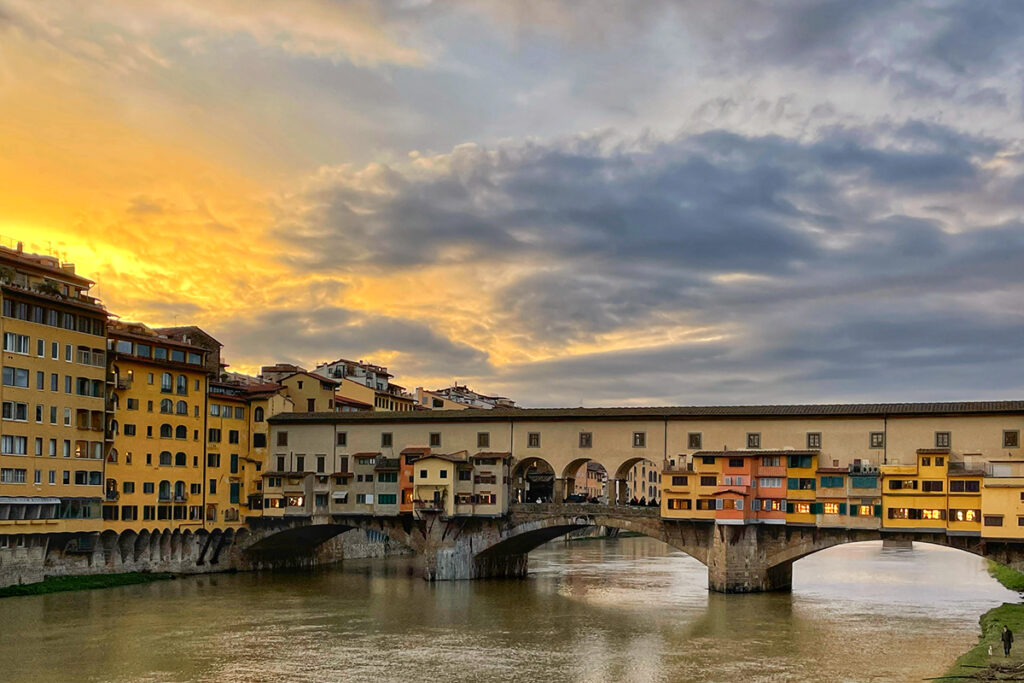
Ponte Vecchio is one of Florence’s most iconic landmarks. And even though it’s always busy, buzzing with tourists, a stroll along Ponte Vecchio is one of the essential things to do in Florence.
Guidebooks talk about wonderful views of the Arno River from the bridge, but I think the view of the bridge from the river bank is far more picturesque, especially at sunset.
If you have the time, continue walking up the street from the bridge to explore the charming neighbourhood of Oltrarno. This is where you’ll find the best artisan shops in Florence.
Gallerie dell’Academia
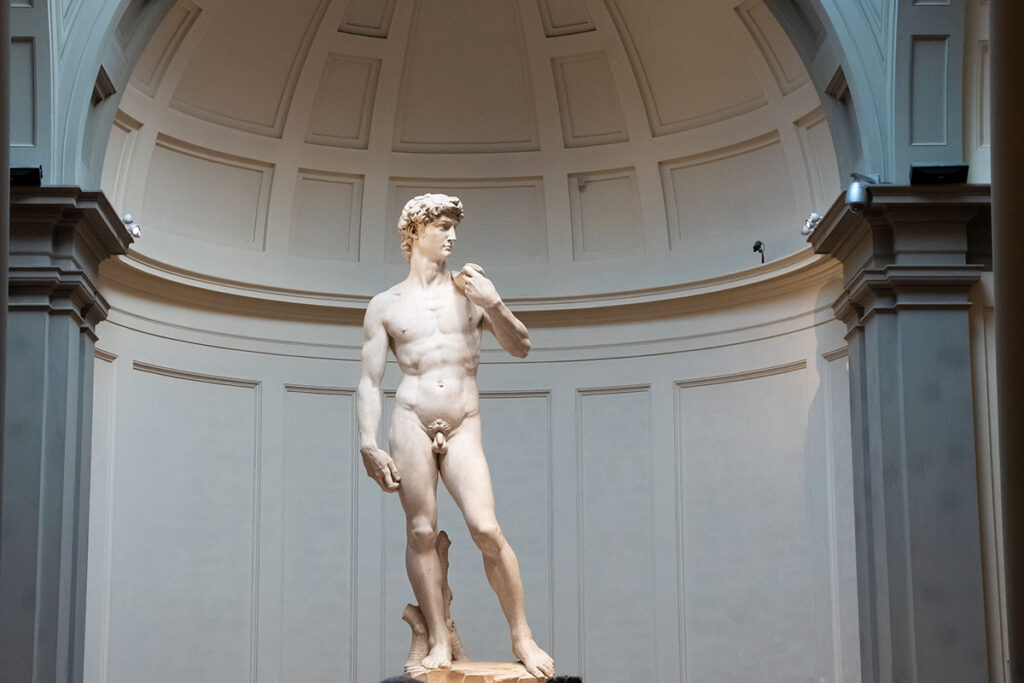
- Time to visit: 1 hr
- Tickets: Timed entry tickets on the official Academy Gallery website
- Last-minute tickets: Skip the line entry and audio guide
Have you really been to Florence if you haven’t seen Michelangelo’s David? You may have seen a copy of the monumental statue in front of Palazzo Vecchio or one at Piazza Michelangelo, but the real David is safeguarded in the Academia Gallery.
If the thought of another museum doesn’t excite you, don’t worry, it doesn’t need to be a long visit. Academia Gallery is quite small. Once you walk through the Hall of Colossus with several sculptures by Michelangelo, towards the magnificent David, admire some paintings, including several by Sandro Botticelli, and explore Bartolini’s plaster casts gallery, you are done.
Unless you want to explore the Musical Instruments gallery in a different wing of the museum, and depending on your appetite for Renaissance art, you can see the Gallery in as little as 30 minutes. It is a great option if you are in Florence with kids, for example, and they just want to see David and move on to other things. However, if you are not in a rush, setting aside at least an hour is a good idea.
Make sure to pre-book your tickets online. Then turn up 15 min before your allocated time slot, and you’ll avoid the long queue.
Medici Chapels & Basilica of St Lorenzo
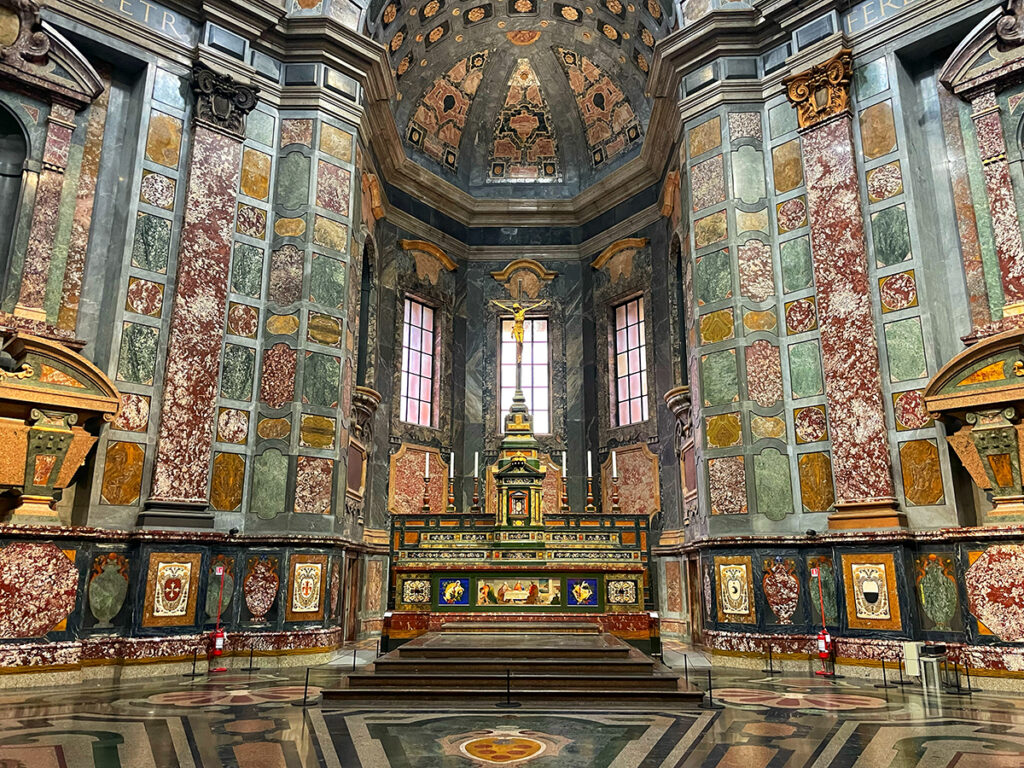
- Time to visit: 30 min to 1 hour
- Tickets: Timed entry tickets online at Tiqets
If you are interested in the Medici family or in Michelangelo’s art, you can’t miss the Medici Chapels. The chapels form part of a monumental complex at the Basilica of San Lorenzo, the parish church of the Medici family. The chapels have a separate entrance to the basilica and require a separate ticket/booking. As with all famous sites in Florence, it’s best to buy your tickets online in advance.
The main rooms to see at the chapels are the New Sacristy, designed by Michelangelo, where his statues adorn the sarcophagi of prominent Medici family members, and the monumental Chapel of the Princes, strikingly decorated with white, red, and green marble.
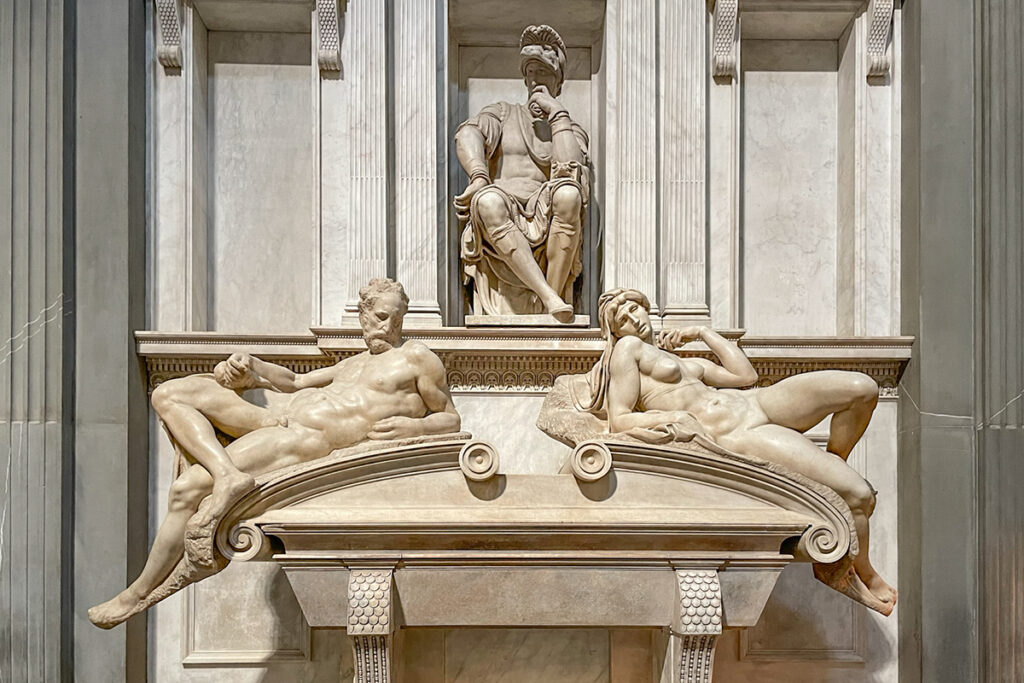
Basilica of San Lorenzo
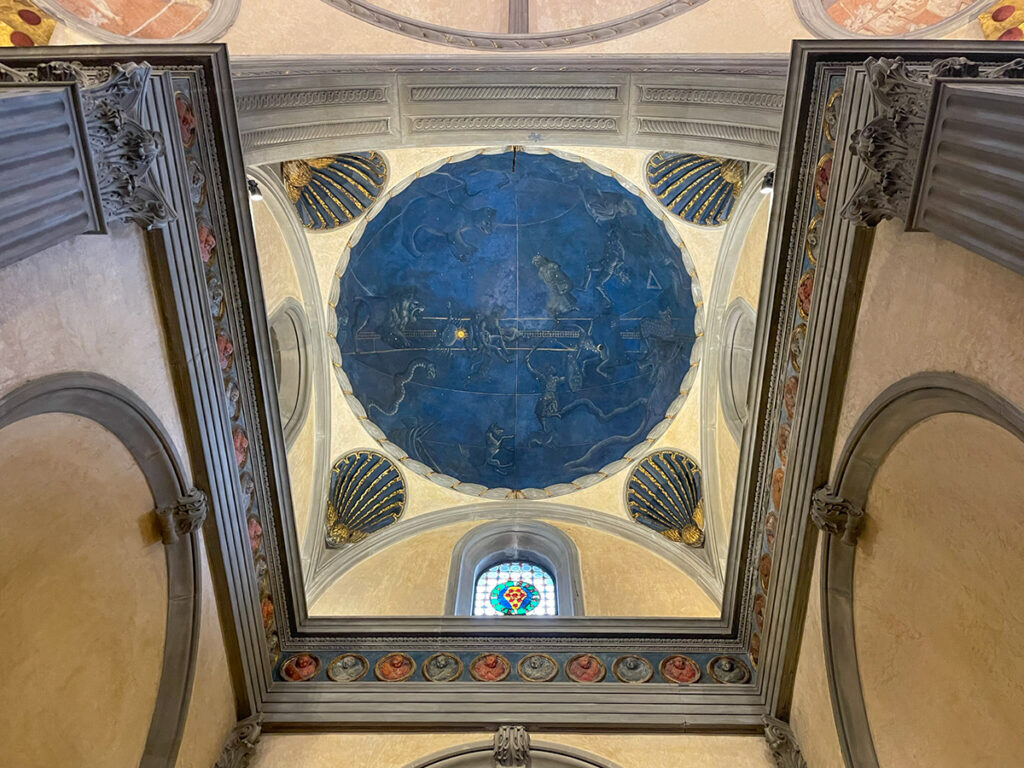
- Time to visit: 30 min – 1hr
- Tickets: Purchase at the Basilica (separate ticket for the library)
Medici Chapels are part of the larger complex of the Basilica of San Lorenzo. From the street, San Lorenzo is not much to look at. The exterior of the basilica appears rough and unappealing. This is because it was never finished. It was supposed to be covered by a spectacular façade by Michelangelo, but due to lack of funds and changes in the Medici family’s fortunes, the decorative covering was never added.
The most interesting space in the basilica is the Old Sacristy. The room is almost a perfect cube with semicircular arches and a segmented hemispherical dome. Brunelleschi was a pioneer in using the principles of geometric optical linear perspective in architectural design. And he applied his mathematical knowledge to the design of the Old Sacristy, fusing science and art.
In 1444, Cosimo founded the first public library in Europe – the Laurentian Medici Library. The library was first housed at the Medici palace, but Michelangelo later designed a dedicated space for it adjacent to the basilica. The spectacular library contains over 3,000 manuscripts collected by the Medici family.
Piazza della Signoria
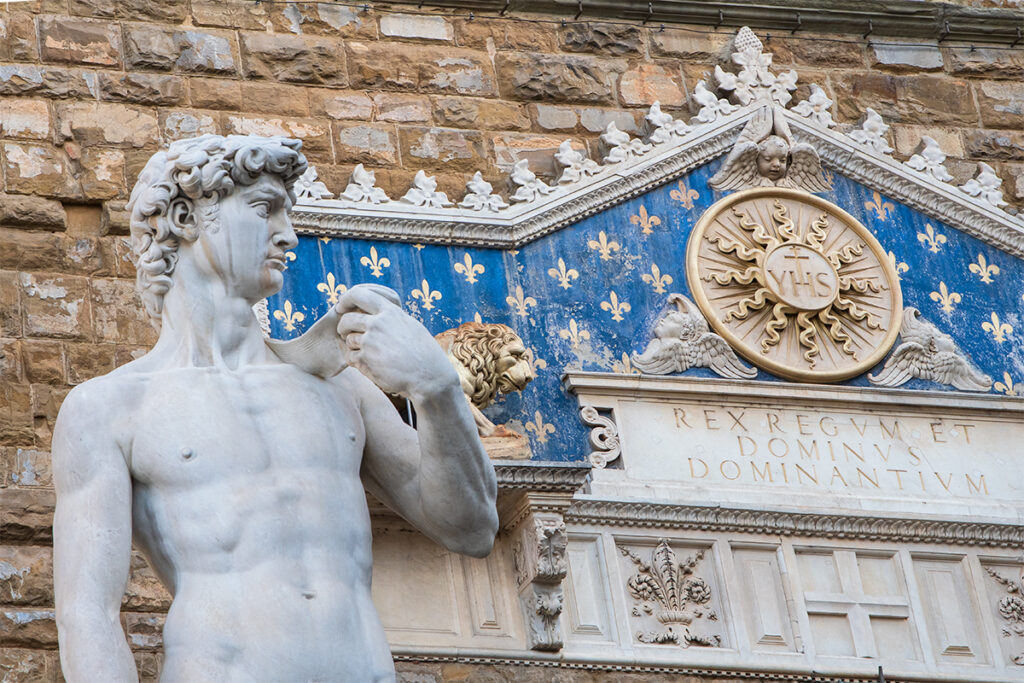
Dominated by the fortress-like structure of Palazzo Vecchio – the seat of Florentine government since the 13th century, Piazza della Signoria is the civic heart of Florence and an open-air museum of Renaissance art, which makes a visit to the piazza one of the best free things to do in Florence.
The entrance to the palace is flanked by a replica of Michelangelo’s David – the symbol of Florence, gazing toward the Uffizi Gallery located right behind the palace. To the right of David is Bandinelli’s Hercules and Cacus, and to the left is the imposing Neptune fountain.
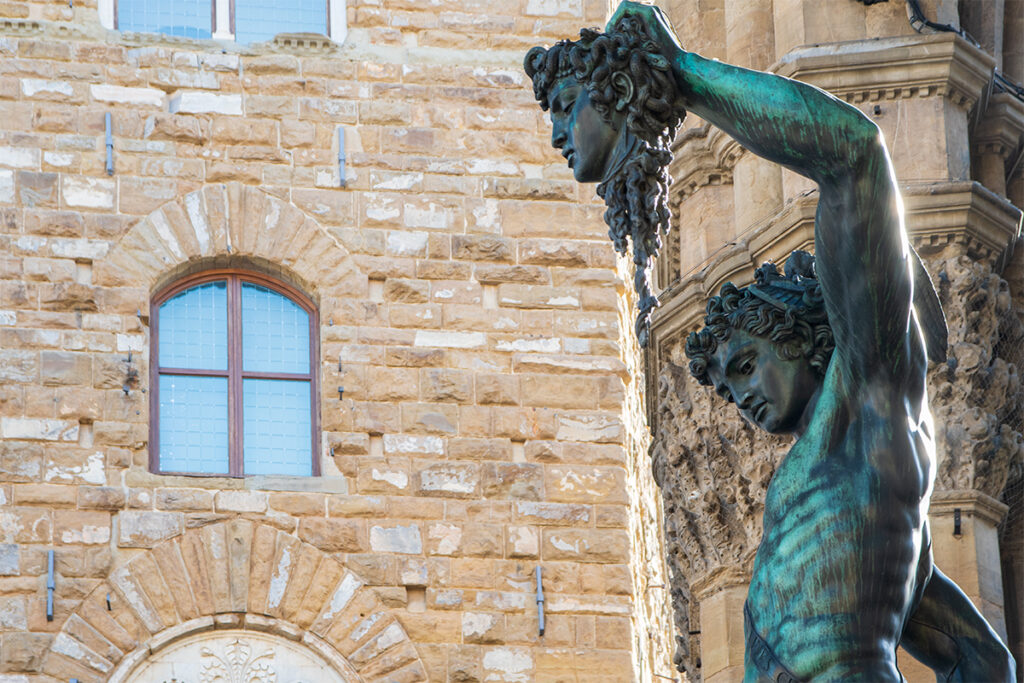
To the right of the palace is the Loggia dei Lanzi – an open-air gallery originally intended as a forum for Florentine citizens to address the city. The Medici later turned the loggia into an art gallery – fine art was more important than free speech to the Renaissance rulers of Florence.
A curious bit of trivia – when you face the Loggia from the steps in front of it, you’ll see two lions flanking the stairs. The one on the left is from the Renaissance, but the one on the right is a thousand years older, dating back to Roman times.
Palazzo Vecchio
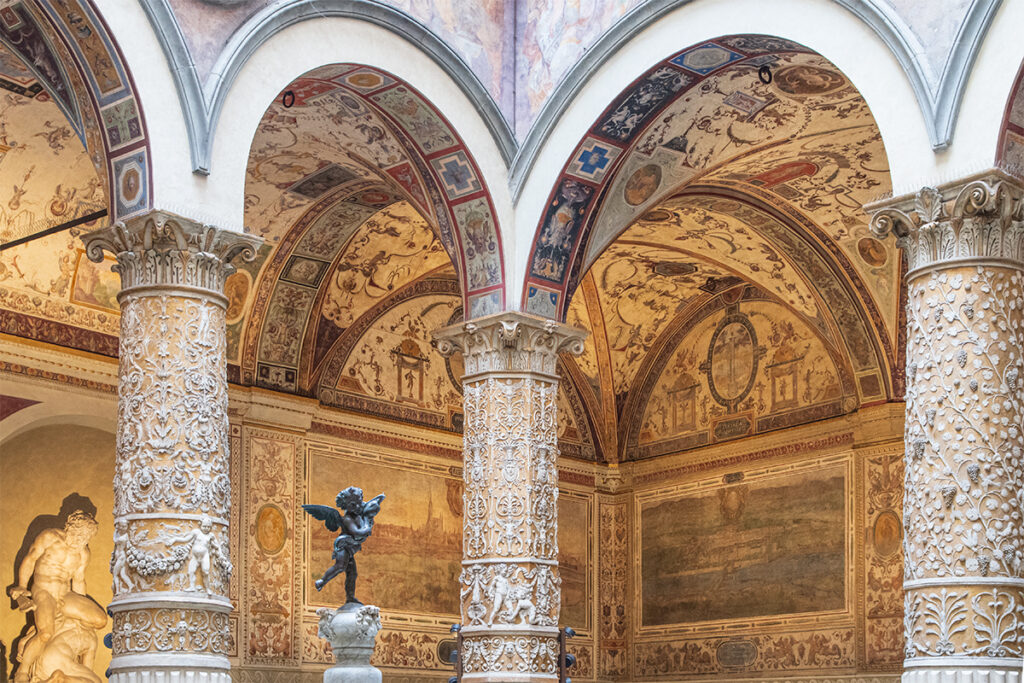
- Time to visit: 1-2 hrs
- Tickets: timed-entry tickets on the Florence Civic Museums website.
- Palazzo Vecchio and Arnolfo Tower tickets only on Tiqets
- Best guided tour: Secret Passages tour
Towering over the southeast corner of the Piazza Della Signoria, Palazzo Vecchio looks more like a fortress than a palace. And that is because when it was built in 1299, security was much more on Florentines’ minds than refined architecture. However, the interior of the palace is anything but rugged. It is exquisitely refined.
From the Hall of the 500, where da Vinci’s painting may still be concealed behind a false wall on which Vasari painted his frescoes, to the exquisitely decorated Leo X Apartments and the Appartments of Elenora, Palazzo Vecchio is the most spellbinding of Medici’s three palaces in Florence.
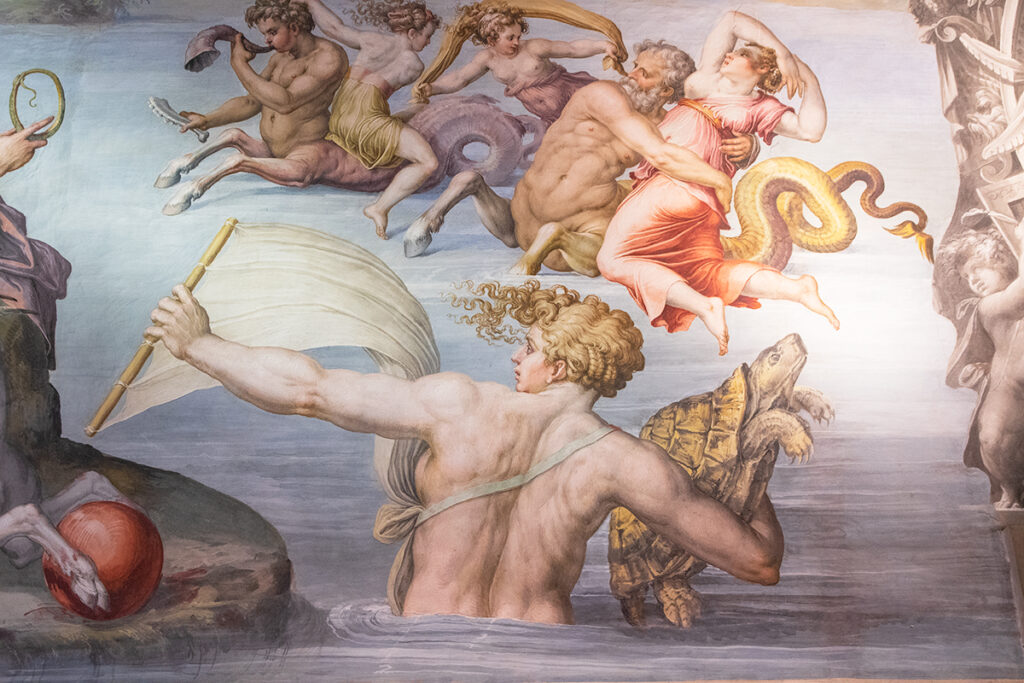
Apart from the spellbinding decor, the palace hides a network of secret passageways that you can explore on a Secret Passageways Tour. The tour is run by the official Palazzo Vecchio tour guides, who have the keys to unlock all kinds of doors at the palace. If you enjoyed the scene of Robert Langdon disappearing into a secret passage behind an ancient map painting in the Inferno movie, you’ll love this tour.
At the end of the tour, you can remain in the palace for as long as you wish. Among the treasures on display in Palazzo Vecchio, you’ll find Dante’s death mask, Donatello’s Judith and Holofernes and Michelangelo’s The Genius of Victory.
READ NEXT: Guide to Visiting Palazzo Vecchio, Florence: Must-see Art and Hidden Gems
Santa Maria Novella Basilica
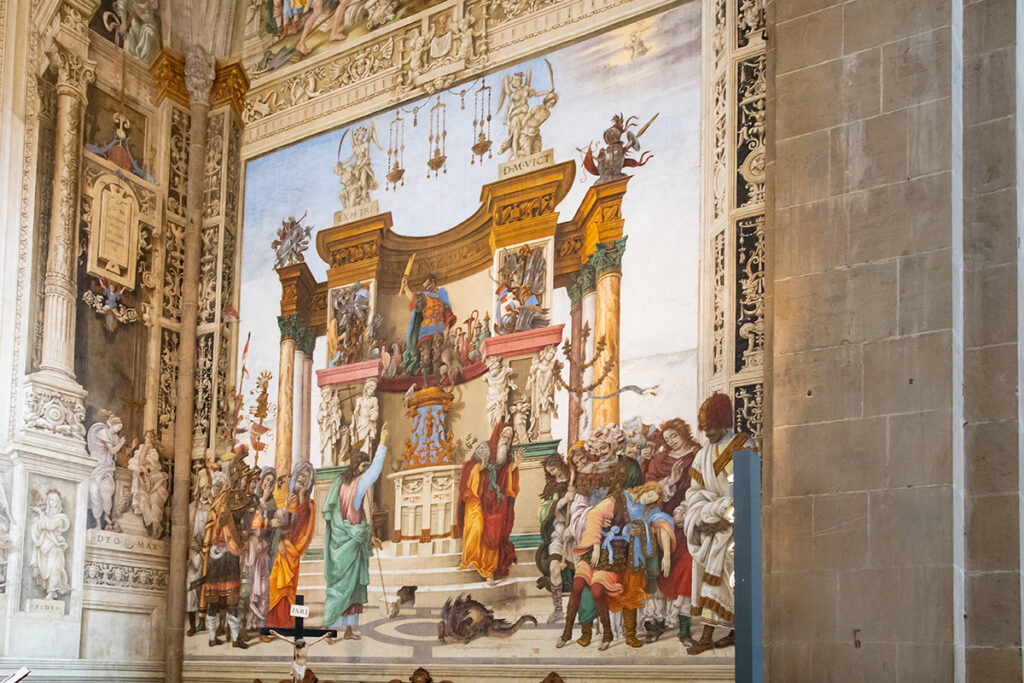
- Time to visit: 30 min to 1hr
- Tickets: Entry with Audio Guide
I find the Santa Maria Novella Basilica (basilica di Santa Maria Novella) to be Florence’s most beautiful church. Over the centuries, its interior has been decorated by works of Giotto, Duccio, Brunelleschi, Botticelli, Masaccio, Ghilrlandaio, Filippino Lippi, Vasari, Paolo Uccello and even Michelangelo.
The entire history of the Florentine Renaissance can be traced in this church, and its frescoes have inspired many artists, including da Vinci, who worked on the cartoon for his Battle of Alighieri in this church while hosted by the monks.
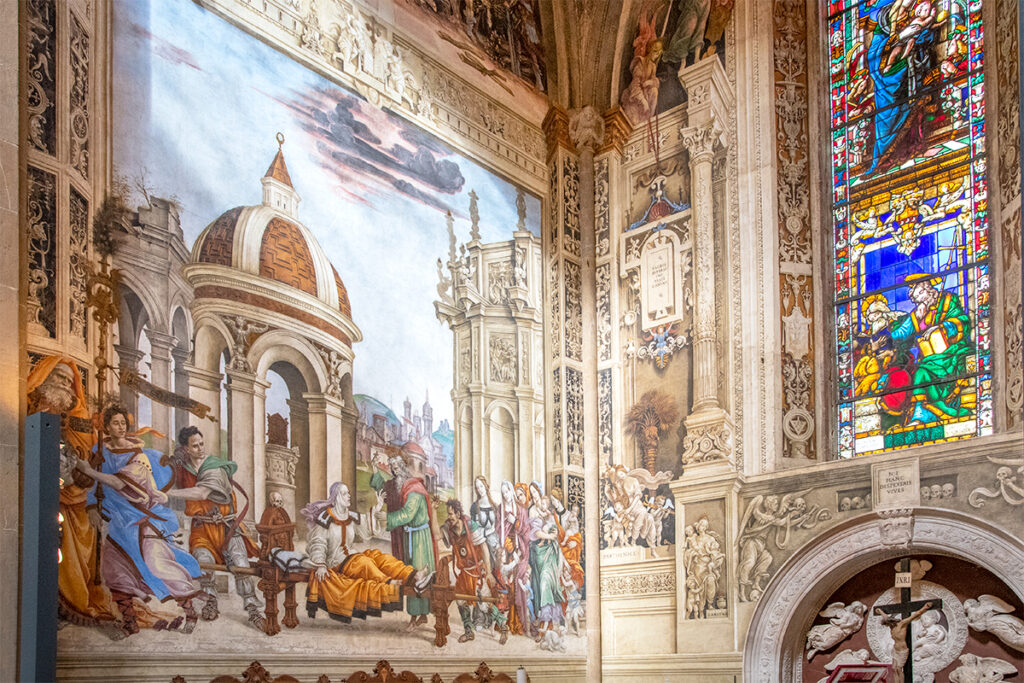
My favourite part of the church is the Chapel of Filippo Strozzi to the right of the altar, with Filippino Lippi’s amazing frescoes, his last works, in fact. There are also crucifixes by Giotto (at the centre of the nave) and by Brunelleschi (in the Gondi Chapel), Holy Trinity by Masaccio, Ghirlandaio’s frescoes in the Tornabuoni Chapel, and Brunelleschi’s pulpit from which Galileo was denounced by the church.
There is so much art by so many artists in Santa Maria Novella that it may be difficult to interpret without a guide. I highly recommend getting an audio guide with your entry ticket.
Santa Maria Novella Perfumery
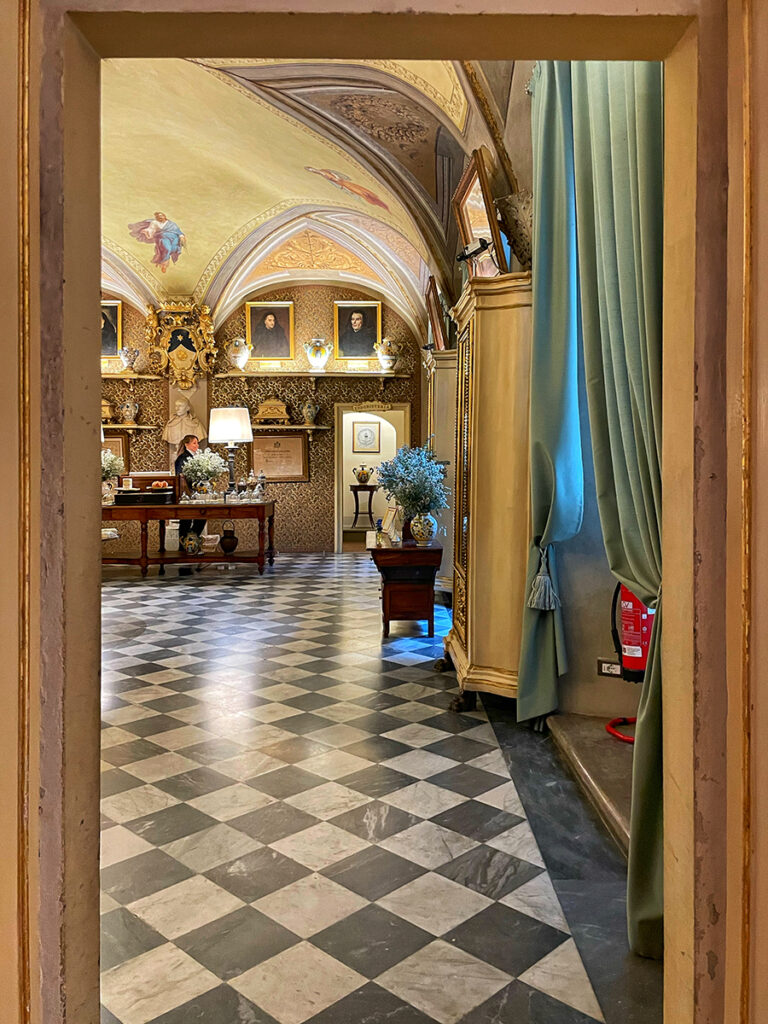
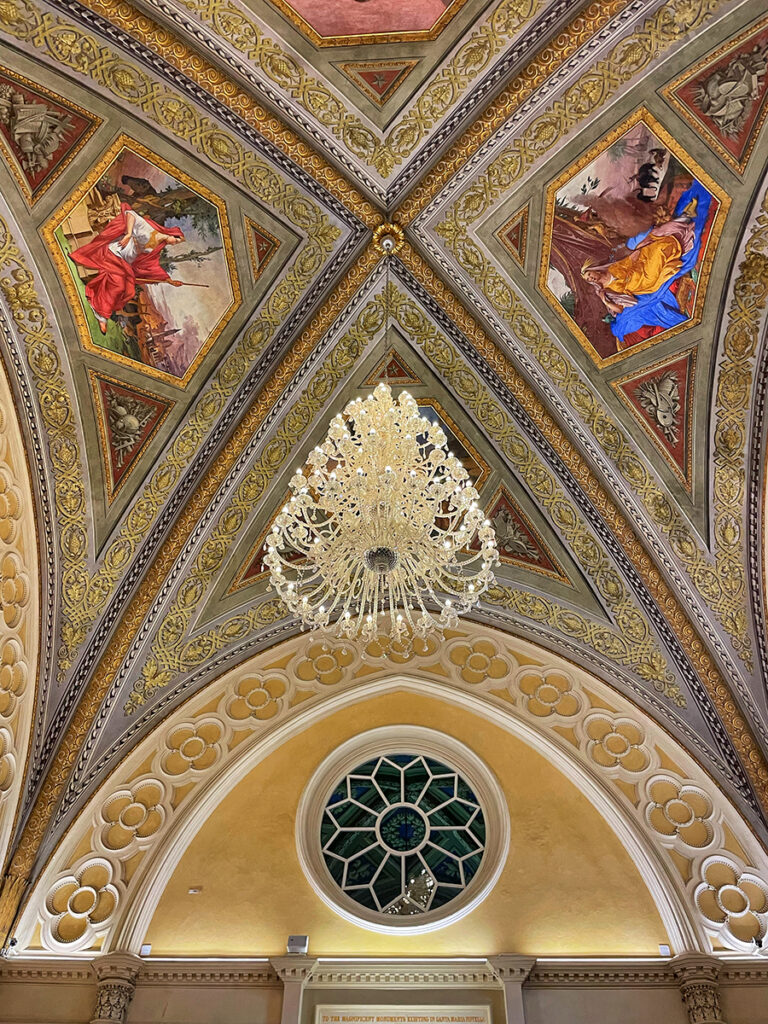
Adjacent to the courtyard of Santa Maria Novella church is the most beautiful shop in Florence – Officina Profumo-Farmaceutica di Santa Maria Novella. It was established as a pharmacy by the Dominican friars living at the monastery, and by 1381, the friars were selling rose water extract as a disinfectant, thought to be particularly useful during the plague. The friars grew their medicinal plants in their kitchen garden.
The present pharmacy dates to 1612, and it is decorated with exquisite Renaissance frescoes and a vaulted ceiling. When Catherine di Medici became the queen of France, the friars created a special perfume for her that is still sold in the store.
Surrounded by such beauty and heavenly scents, you may not be able to resist buying something from their incredibly inviting and picturesque line-up. I couldn’t. My extended stay in Florence was my birthday present to myself, so it felt appropriate to splurge on a perfume created for Catherine di Medici in the 16th century. Florence is a superb birthday trip destination for any age.
Tip: keep in mind that there are 3 branches of the shop in the city, so make sure to go to the original pharmacy on via dell Scale near Santa Maria Novella church.
Basilica of Santa Croce
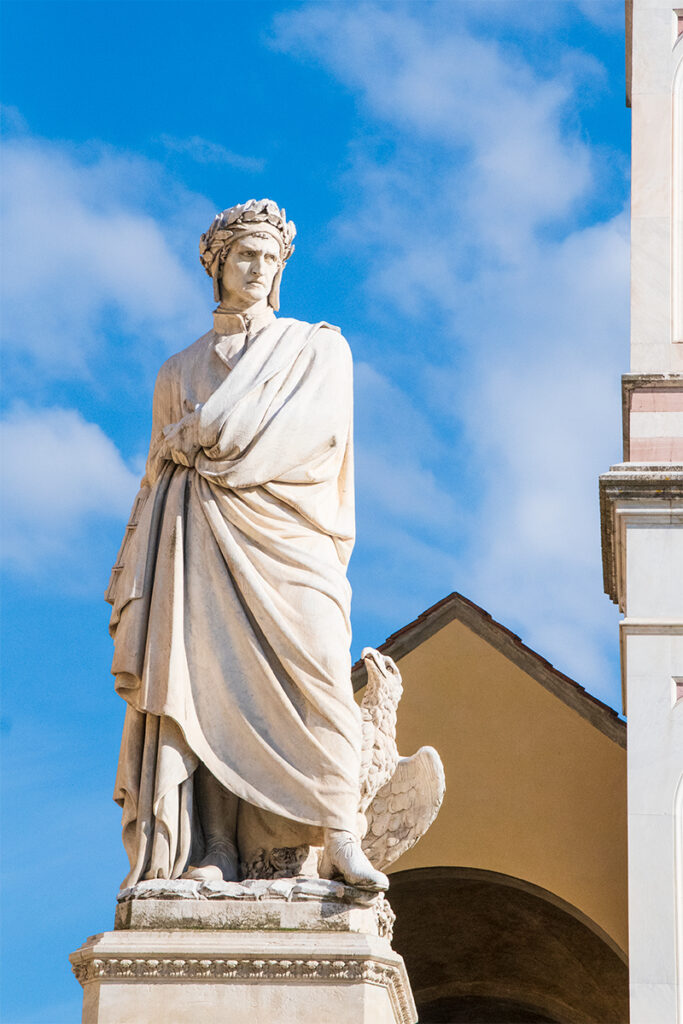
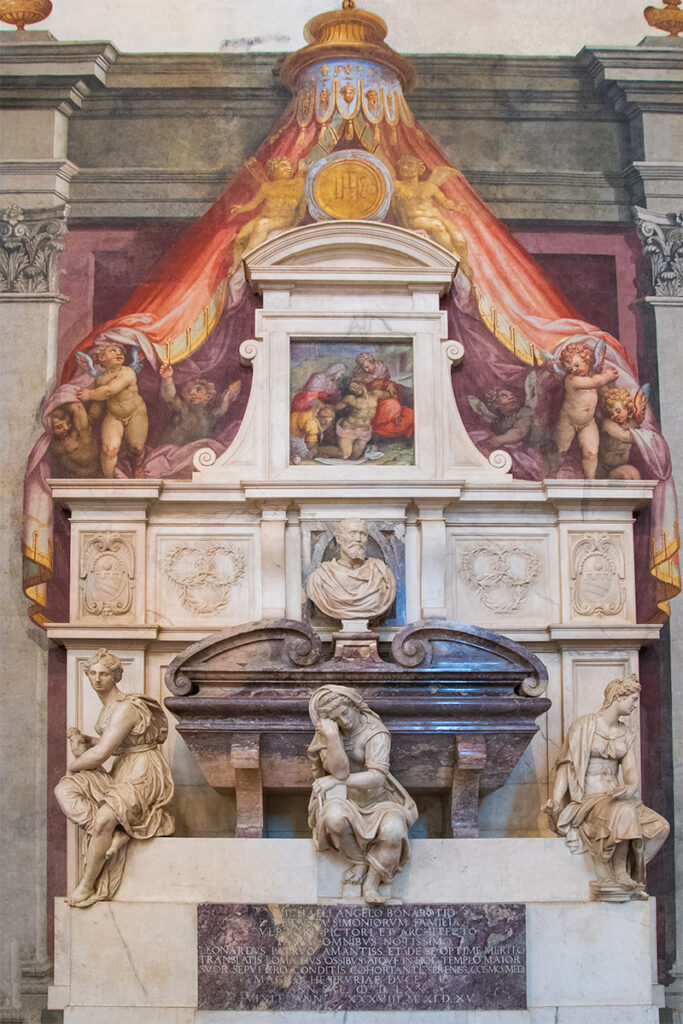
- Time to visit: 30 min to 1hr
- Tickets: Timed-entry tickets
- Best guided tour: Santa Croce Basilica tour
While the Basilica of Santa Maria Novella is a Dominican church, the Basilica of Santa Croce (Basilica di Santa Croce) is a Franciscan basilica dedicated to St Francis of Assisi.
Today, it is famous for being the burial place of some of the most illustrious Italians, including Michelangelo, Machiavelli, Galileo, Rossini, and an honorary sarcophagus of Dante, even though the poet’s remains are buried in Ravenna, where he died. Such famous dead inspired the basilica’s other name – the Temple of the Italian Glories.
Unsurprisingly, the church is decorated with Renaissance masterpieces, including frescoes by Giotto, a crucifix by Donatello, a chapel designed by Brunelleschi, and Michelangelo’s tomb designed by Vasari.
It takes some working out to figure out which sarcophagus is who’s inside the church, and it’s a good idea to take a guided tour of the basilica. With a guide, not only will you know what you are looking at, but you will also learn about some of Florence’s most distinguished personalities and their historical context.
San Marco Monastery
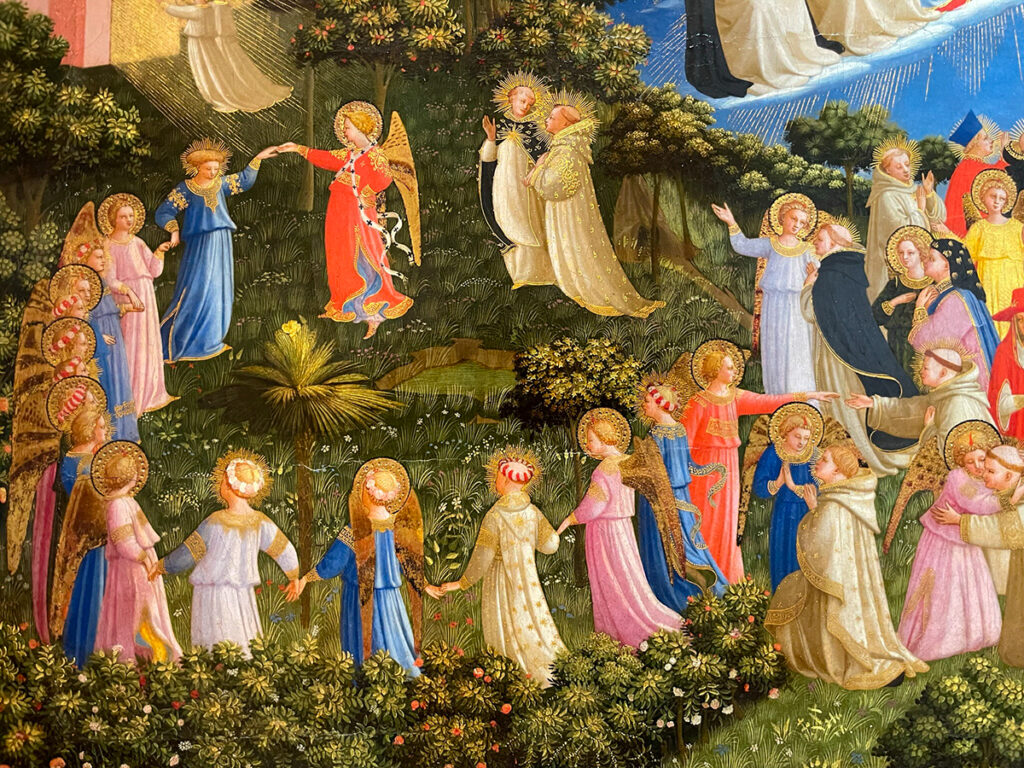
- Time to visit: 1hr
- Tickets: Timed-entry tickets on Tiqets.
San Marco Monastery is a stunning and peaceful escape from the buzz of Florence. The monastery forms part of what was known as the Medici Quarter, along with the Medici family home – Palazzo Medici-Ricardi and the family church – basilica of San Lorenzo. Cosimo di Medici had a cell reserved for himself at San Marco for when he needed it as a retreat from the world.
San Marco Monastery is mainly famous for two of its former Dominican monks who became highly influential figures in Florentine art: Fra Angelico, an artist of the early Florentine Renaissance, and Savonarola, who practically brought the Florentine Renaissance to an end.
Fra Angelico’s frescoes and paintings is what brings most people to San Marco today. On the monastery’s ground floor, Fra Angelico Museum displays a dazzling collection of his paintings and altarpieces. But that’s not all of Fra Angelica’s art at the monastery.
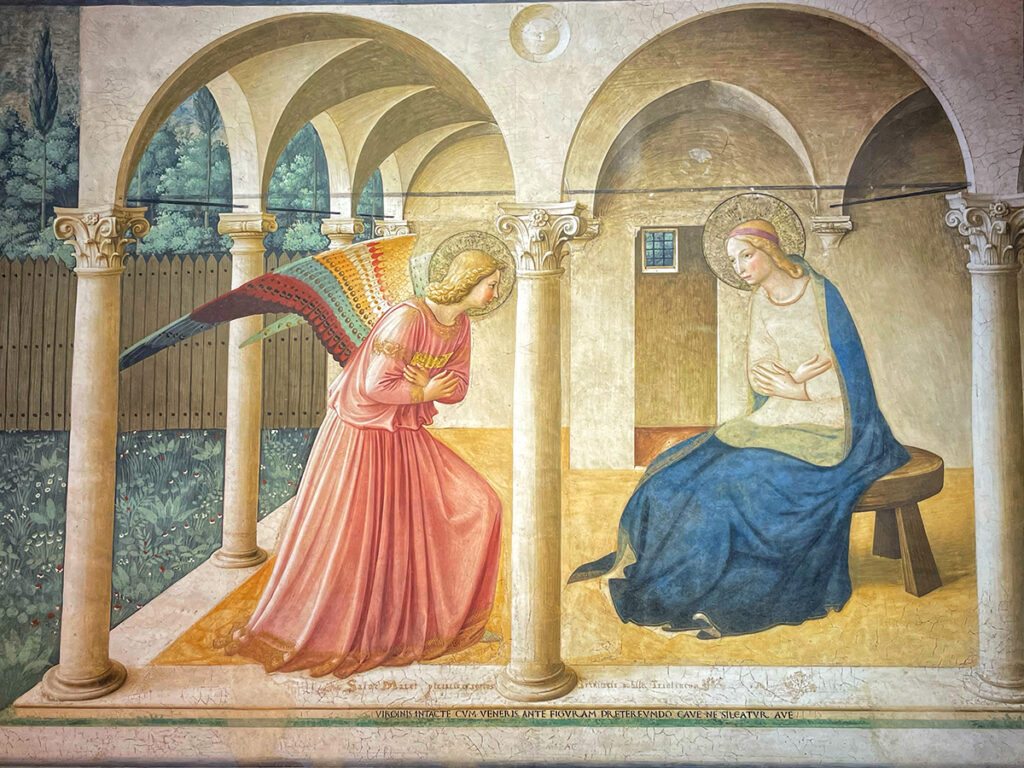
While living at San Marco, Fra Angelico painted frescoes in 9 of the tiny monks’ cells and a large, often copied, fresco of Annunciation at the top of the Dormitory stairs. His most famous work is the altarpiece for San Marco that you can see in the museum.
A century later, another Dominican monk – Savonarola, became a leader of Florence, preaching against corruption in the church, extreme asceticism and the destruction of secular art and culture. In 1497, he infamously held a bonfire of the vanities into which Florence citizens tossed items of luxury, including pieces of Renaissance art.
A year later, he fell out of favour and was burned at the stake on the same spot on Piazza della Signoria where his bonfire of the vanities burned a year earlier.
Palazzo Medici-Ricardi
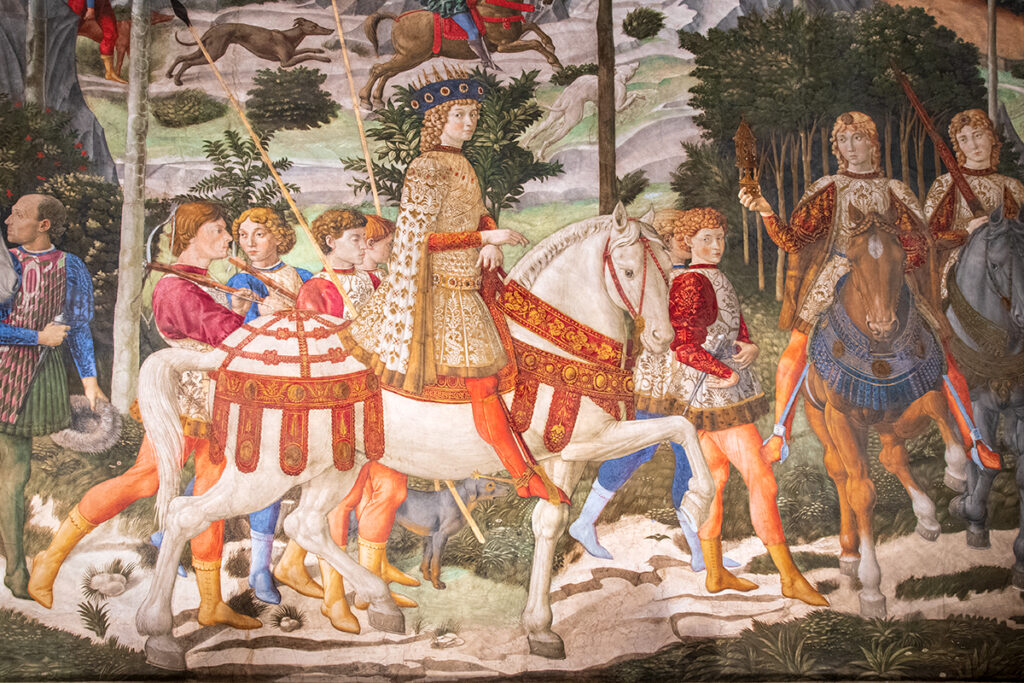
- Time to visit: 30 min – 1 hr
- Tickets: buy on sight
This palace is where the story of the Medici family began. If you watched the Medici TV show, this is the palace where the family lived at the time. It was home to two of the most illustrious Medici family members – Cozimo the Elder and Lorenzo the Magnificent. This was the time of Medici’s greatest patronage of the arts, the era known as the Golden Age of Florence.
Artists like Verrocchio, da Vinci, Botticelli, Ghirlandaio, and Michelangelo were part of the Medici court in Palazzo Medici-Ricardi.
There isn’t much to see inside the palace that dates back to the Medici times, apart from the stunning Magi Chapel, famously frescoed by Benozzo Gozzoli in 1459. The frescos that cover 3 walls in the chapel paint the story of the procession of the three Magi on their way to Bethlehem to witness the birth of Jesus.
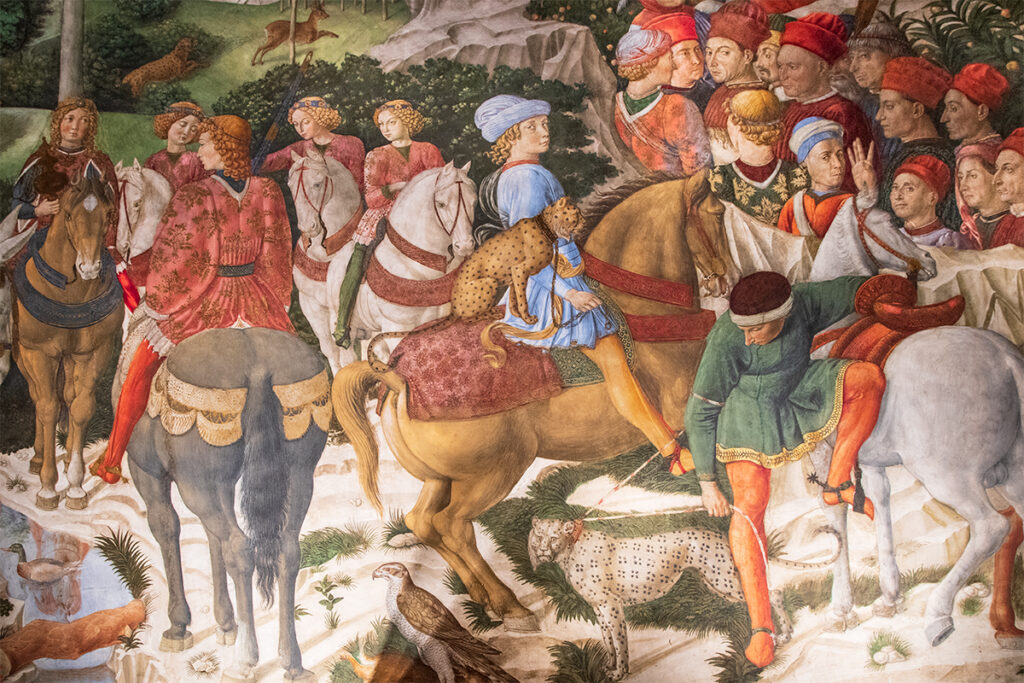
Gozzoli elegantly combined the religious theme with a depiction of several members of the Medici family, including young Lorenzo and Juliano, Cosimo, and their allies like the Byzantine emperor. The frescos are absolutely exquisite, and if you visit early in the day, you might have the chapel to yourself. This is the beauty of visiting Florence in winter.
Brancacci Chapel
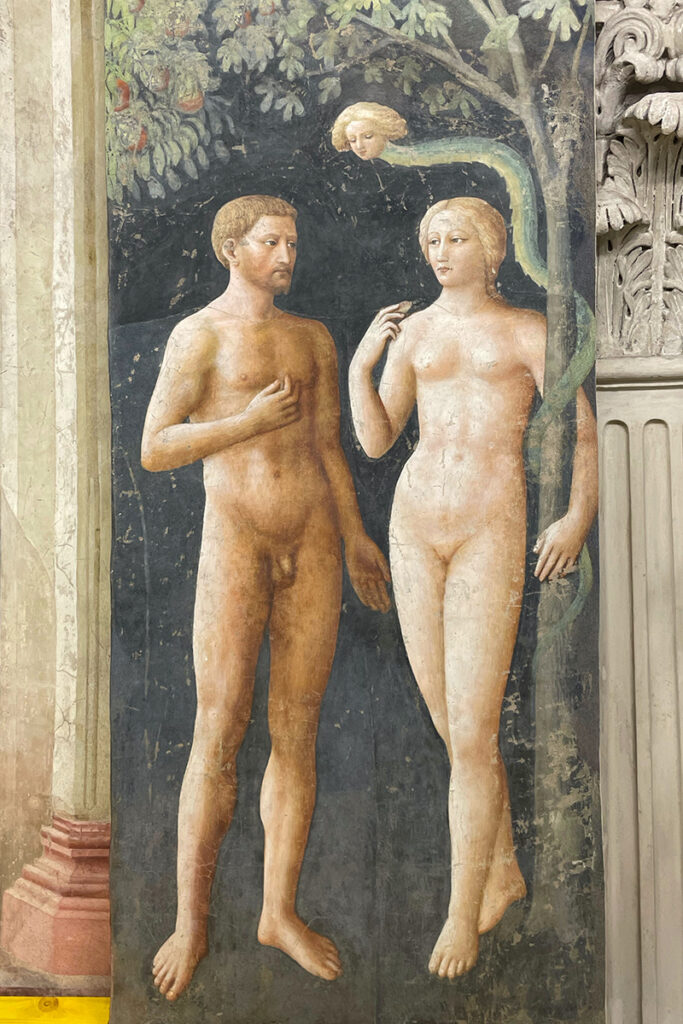
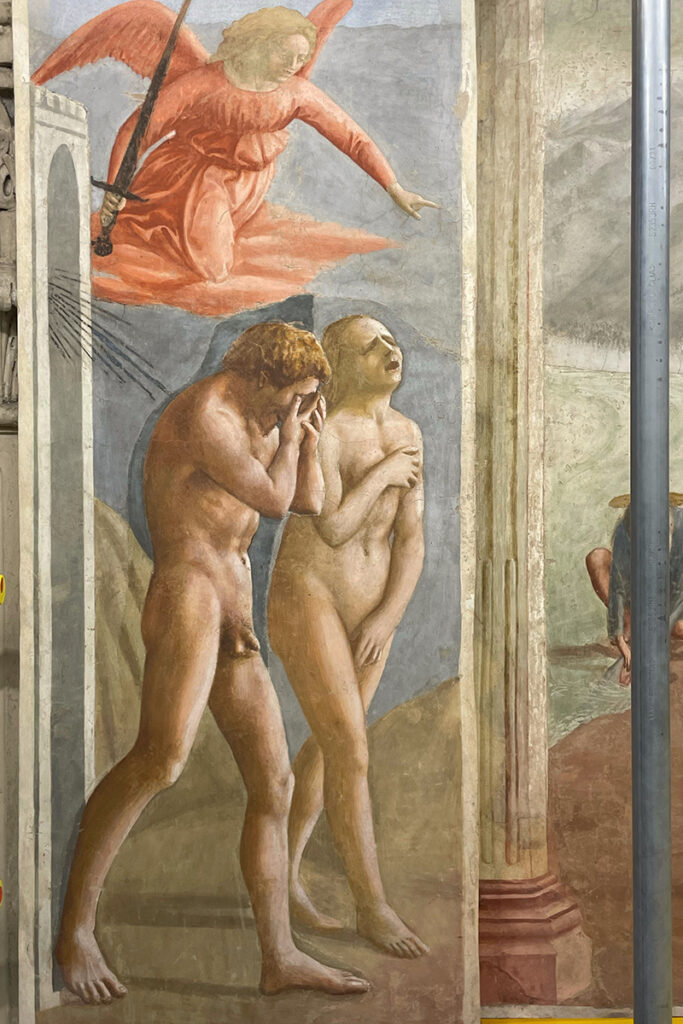
- Time to visit: 30 min to 1hr
- Tickets: Florentine Civic Museums website
- Best tour: Guided tour in English
This stunning chapel (Cappella dei Brancacci) in the Church of Santa Maria del Carmine in Oltrarno was considered a training school for Renaissance artists. Both Michelangelo and da Vinci studied Masaccio’s frescos and his use of light to define the human body.
Unlike the flat light in medieval art, Masaccio painted the scenes in his frescos as if they were illuminated by a single source of light, like the chapel’s window. By accentuating the play of light and shadow, he gave his painting a natural and realistic appearance – a technique that da Vinci later mastered like no other artist.
The frescos in Brancacci Chapel were initially designed by Masolino da Panicale, but he was shortly called away, and his 21-year-old student Masaccio did most of the painting. Although Masaccio was also called to Rome before he could finish the chapel, and Filippino Lippi completed the remaining sections.
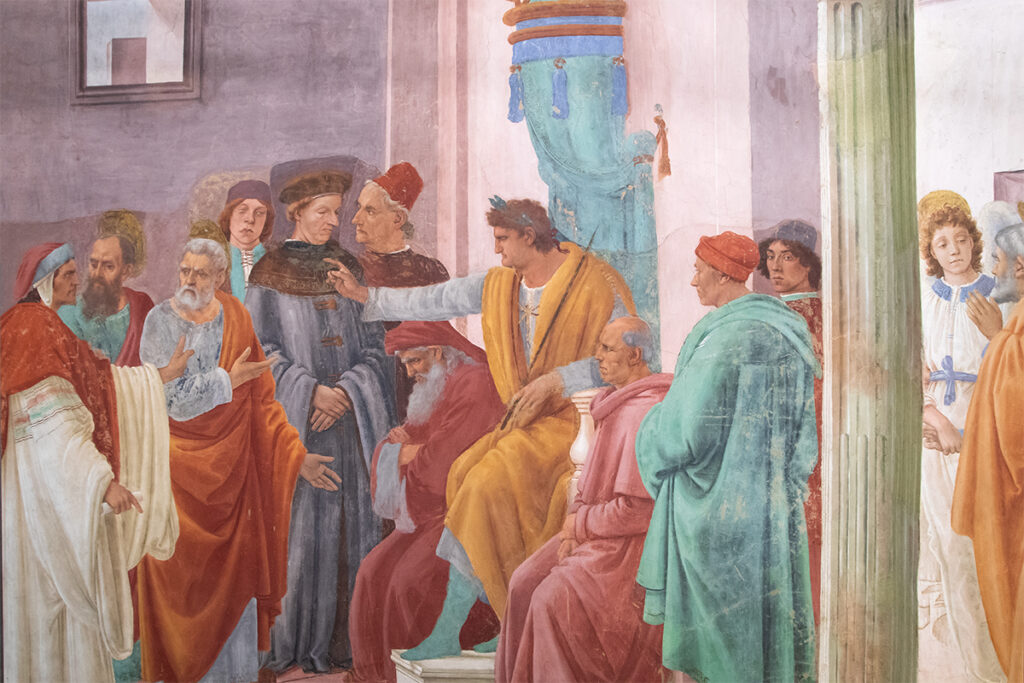
The chapel is currently under restoration, but this doesn’t mean you can’t visit it. You just need to buy your ticket in advance. The visits to the chapel are led by an official host, who simply takes you to two different levels of scaffolding without providing any commentary. You get about 10 minutes at each level.
While this means that you can’t see the entire chapel at once, thanks to the scaffolding, you get to admire the frescos at eye level.
Pitti Palace & Boboli Gardens
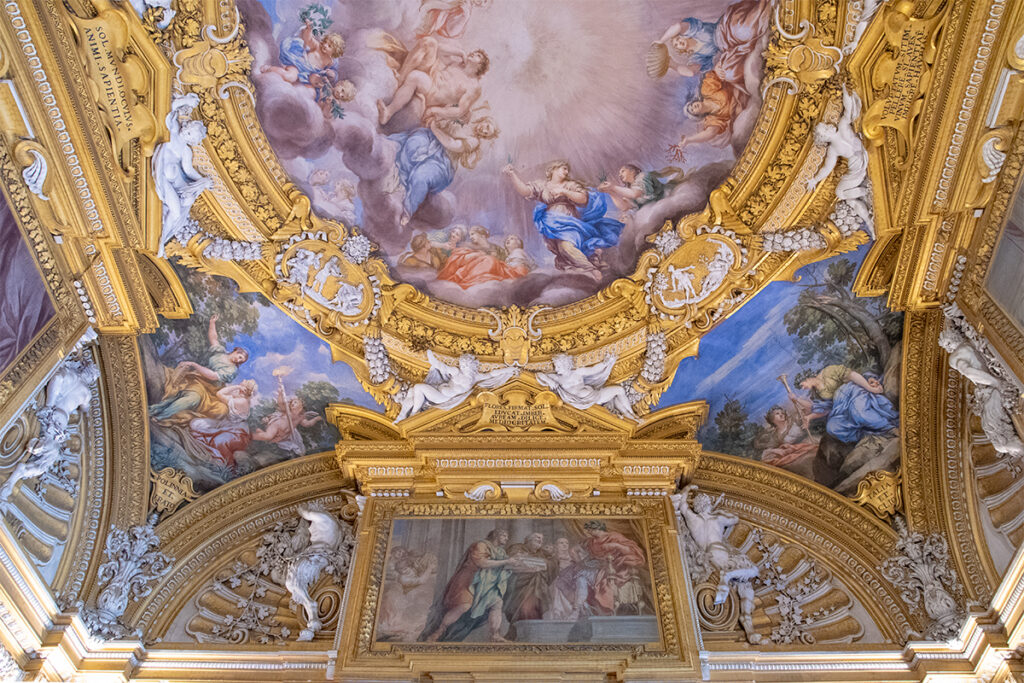
- Time to visit: 2 hrs
- Tickets: Consider a combined ticket with Uffizi Gallery and Boboli Gardens.
- Alternatively, purchase just the Pitti Palace entry tickets.
- Best Tour: Pitti Palace and Palatine Gallery Ticket and Tour
In 1550, Cosimo I de Medici and his wife Eleanor of Toledo moved the Medici court from Palazzo Vecchio to Palazzo Pitti on the southern bank of the Arno River to enjoy the fresh air of the Boboli Gardens. It is the largest and the most lavish Medici palace in Florence. In later centuries, the Habsburg-Lorraine dynasty occupied the palace, which succeeded the Medici in 1737, and the first Kings of unified Italy from 1865.
The entire first floor of the expansive palace is taken up by The Palatine Gallery and Royal and Imperial Apartments. These over-the-top halls house the Medici art collection, including the largest selection of paintings by Raphael in the world and works by Titian, Tintoretto, Caravaggio and Rubens.
Boboli Gardens
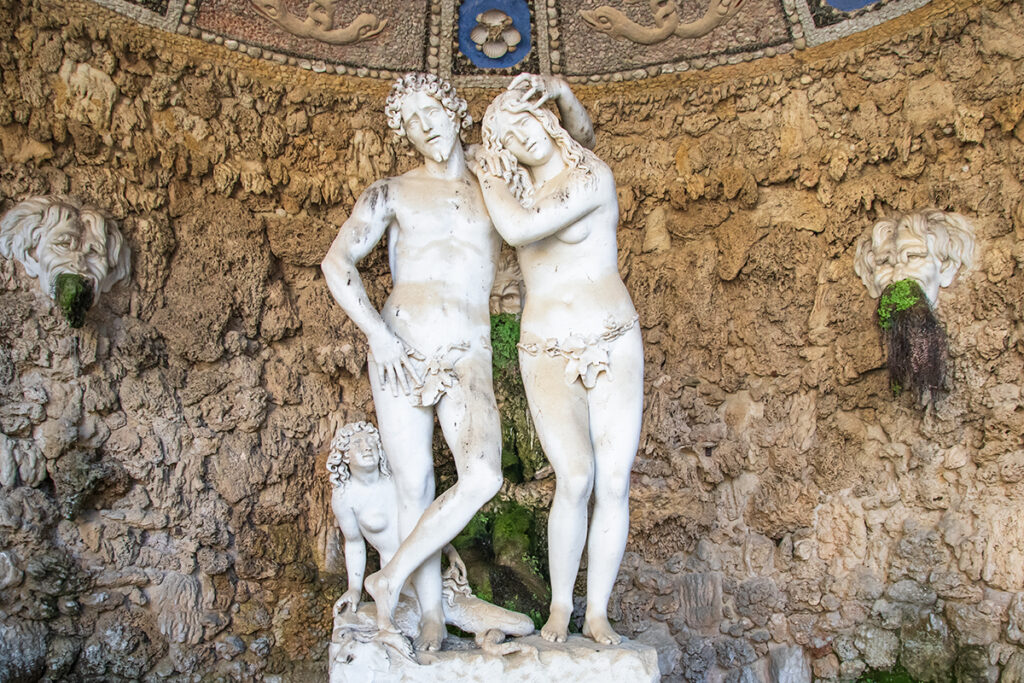
- Time to visit: 1 hr
- Tickets: Uffizi website or on GetYourGuide.
- Consider a combined ticket with the Uffizi Gallery and Pitti Palace.
The palace opens up on the sprawling Boboli Gardens that take up the entire hill from the palace to the city wall. There is enough Renaissance art in the gardens to venture on a leisurely treasure hunt. Right outside the palace is the stunning Buontalenti Grotto with artificial stalactites and stalagmites and Michelangelo’s four Prisoners statues set to support the grottos’ walls (the original statues are housed in Gallerie dell’Academia).
Pitti Palace is enormous. As are Boboli Gardens. If you are concerned about missing great works of art, it is best to join a tour of the palace and the gardens.
But if you are not too worried about learning what is what and simply want to walk through a sumptuous palace, the most economical way of purchasing a ticket is to get a combined Uffizi Gallery, Pitti Palace and Boboli Gardens ticket. Just make sure to hold on to it between your visits to each place. If you lose the ticket, you’ll have to pay for a new one-off ticket, and you’ll have to queue up for it.
Bargello Museum
Located in the former prison, across the street from Badia Fiorentina church where, according to legend, Dante saw his beloved Beatrice for the first time, the Bargello museum houses most of Florence’s statues and sculptures.
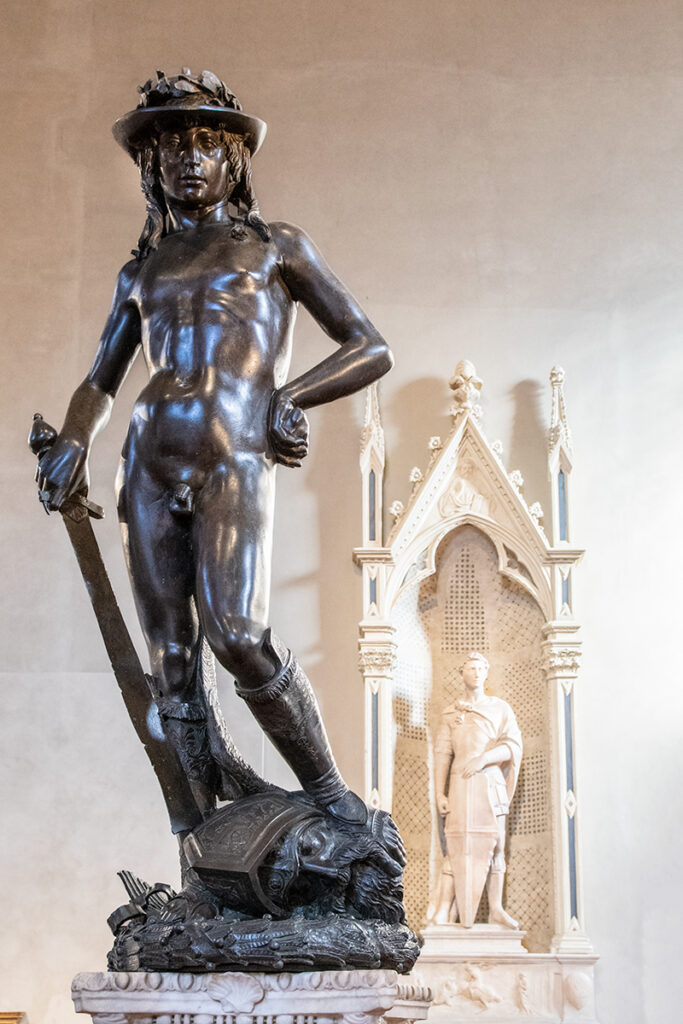
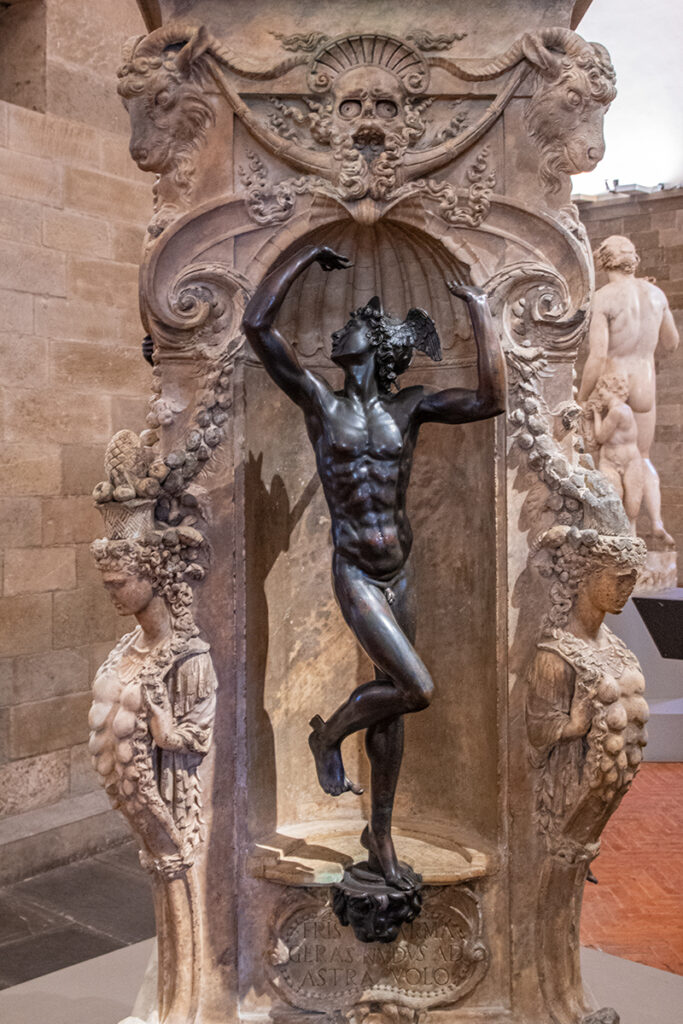
- Time to visit: 1hr
- Tickets: Timed-entry tickets on Tiqets
The most famous works include Donatello’s bronze David, possibly the first nude sculpture of the Renaissance, Michelangelo’s David Apollo and Bacchus, Giambologna’s Mercurius and Ghiberti’s and Brunelleschi’s panels that they submitted for the competition to design the doors for the Baptistery.
If you are a fan of Leonardo da Vinci, don’t miss Rustici’s Anghiari Battle, which he modelled on Leonardo’s drawings for his monumental fresco for Palazzo della Signoria (now Palazzo Vecchio)
Basilica Santo Spirito
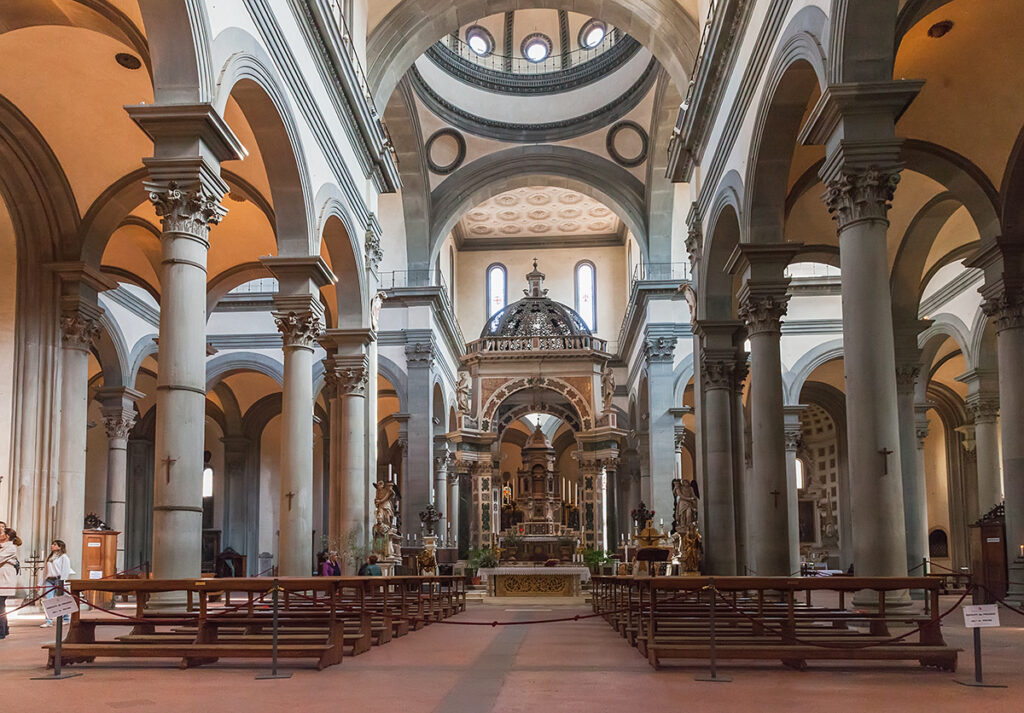
- Time to visit: 15 – 30 min
Located in a quiet corner of Oltrarno, not far from Brancacci chapel, Basilica of Santo Spirito (Basilica di Santo Spirito) is the last work of the great Renaissance architect Filippo Brunelleschi, of the Duomo Dome fame.
The exterior of the church appears rather plain – you can easily walk past without noticing it. Which is what makes it a lovely hidden gem. The interior of the church, however, is quite an impressive site.
The space is divided into three aisles by rows of soaring columns. The geometrical symmetry of the church is set off by the uniform colours of its walls and the arched ceiling. Creamy whites, dark greys and earthy oranges accentuate the symmetry and create a particularly harmonious appearance.
In 1492, the basilica provided refuge to the young Michelangelo after his patron Lorenzo the Magnificent’s untimely death. The friars allowed Michelangelo to study human anatomy by dissecting the corpses in the convent’s hospital. As a gesture of gratitude, he sculpted a wooden crucifix for the altar. After missing for over three centuries, the crucifix returned to the basilica and can now be viewed in the octagonal sacristy.
Sunset Viewpoints
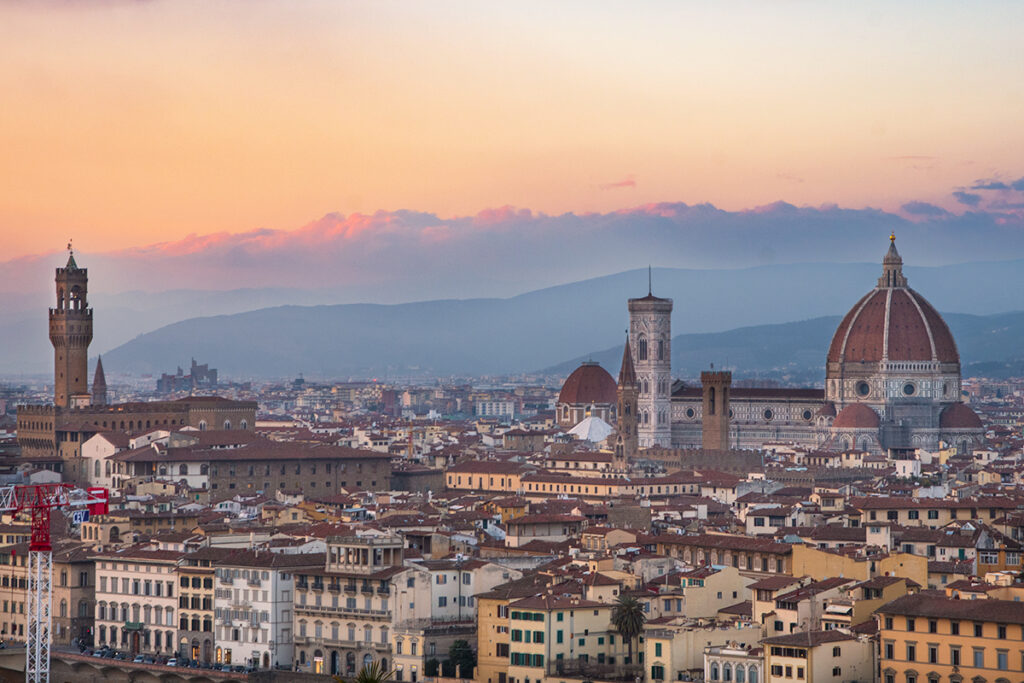
Florence lies in the valley, surrounded by mountains. And the best place to watch a sunset in Florence is from one of the hills. You have two options, and both are about a 20-30 minutes walk from the Duomo, across the Arno River and up a steep hill.
If you enjoy the party atmosphere, head to Piazza Michelangelo. It is a large square overlooking the city, with a replica of Michelangelo’s David and various food, drink, and souvenir stalls. There are usually street performers entertaining the mostly young crowds while they wait for the sunset.
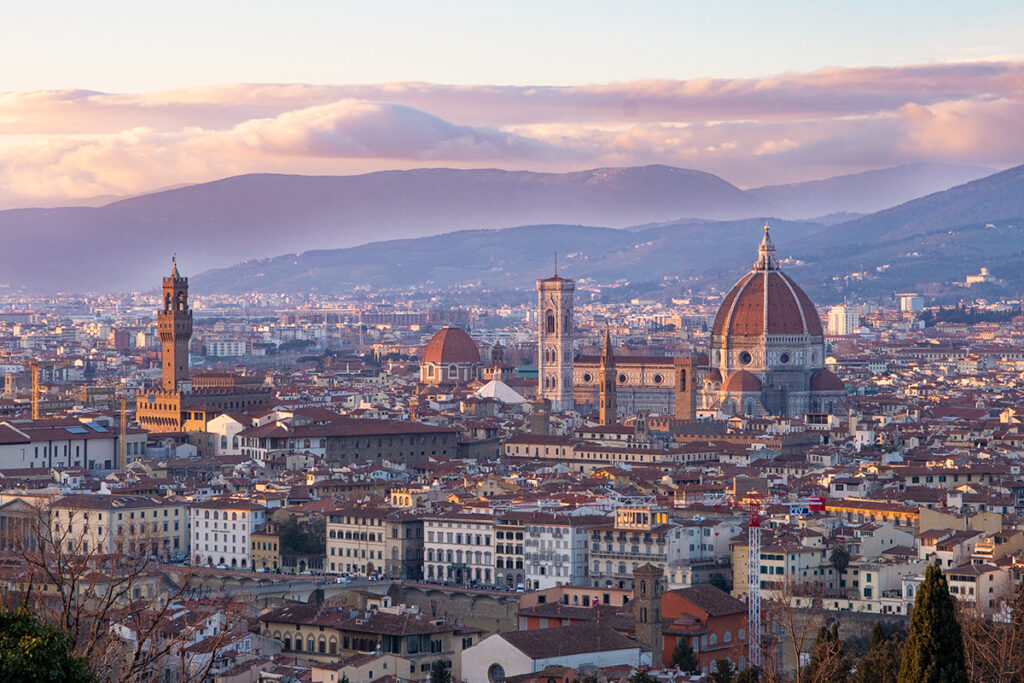
If the sight of an excited crowd makes you want to run the other way, go to Abbazia di San Miniato al Monte instead. The view here is almost the same, and instead of a party crowd, there is a beautiful medieval church here that you can visit before the 6.30 pm service. You can visit the service too and listen to the monks’ soulful singing, but you won’t be able to walk around the church during the service.
Clet’s Steet Art
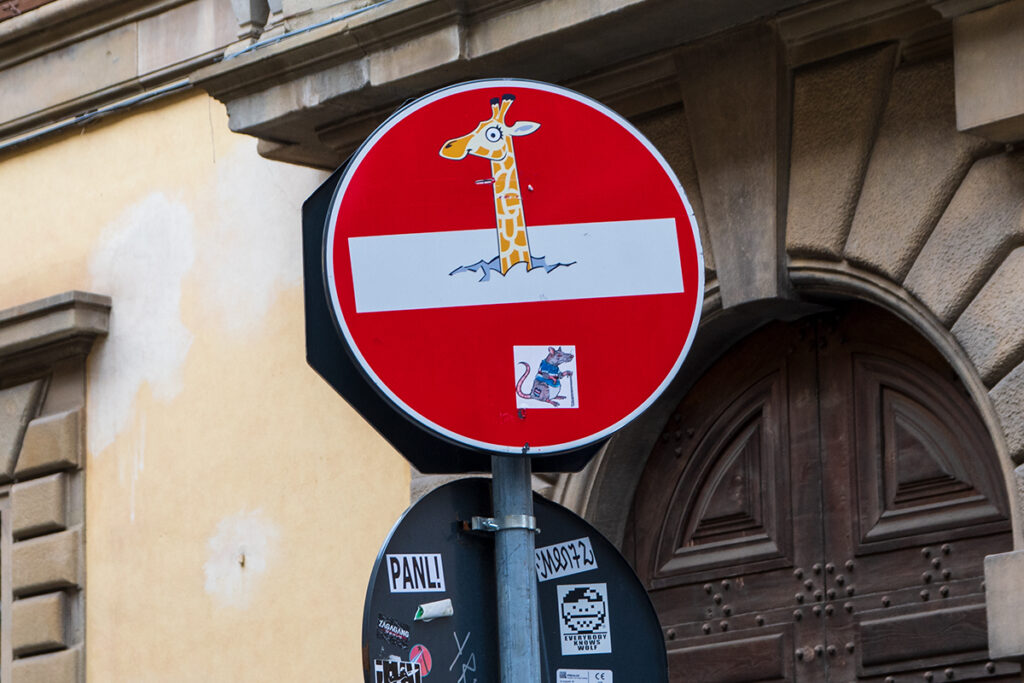
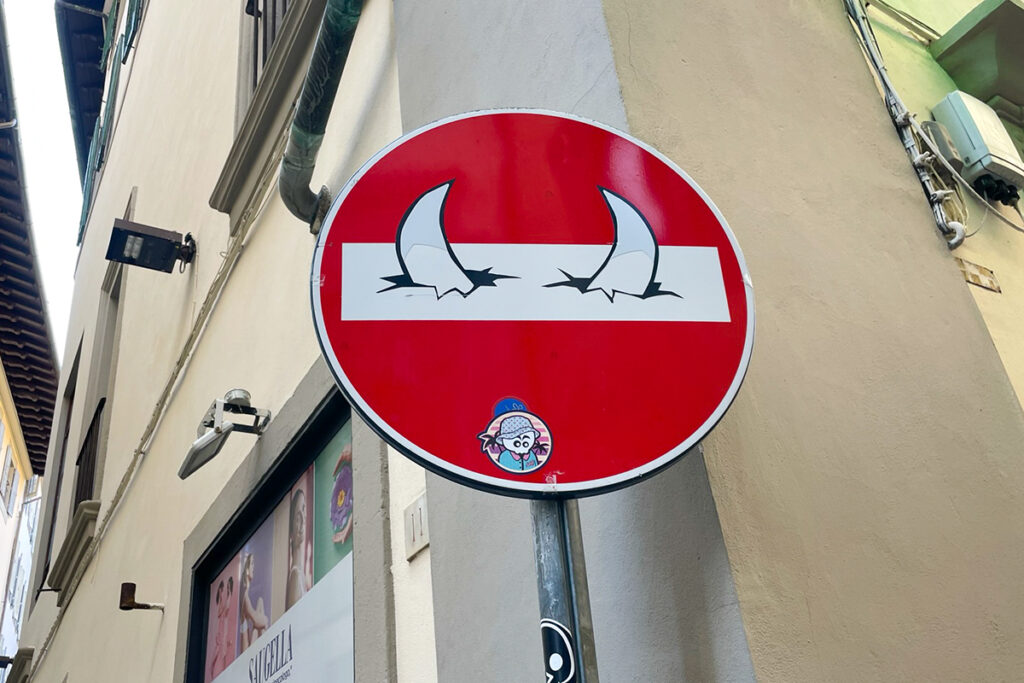
For a bit of a break from the Renaissance, keep an eye out for cheeky art by Clet on Florentine street signs. His artistic alterations to the road signs pop up unexpectedly here and there and always put a smile on your face. Here are a couple of signs I came across. See how many you’ll spot.
How to Get to Florence
Getting to Florence in winter is not any different to any other season. You can fly to Florence airport, which is just over 9 km away from the historic city centre (a 20-min taxi ride).
However, the most convenient way of getting to Florence is by high-speed train. Driving & parking in Florence can be a chaotic nightmare, and the high-speed trains are faster and more relaxing than flying. Direct trains from Roma Termini depart every 30 minutes, taking just over 1.5 hours.
The easiest way to book train tickets in Italy is via Omio app. You can show your electronic tickets to the conductor in the app – no need to print anything. And you’ll have all your train tickets in the same place regardless of what train network you travel with.
Where to Stay in Florence in Winter
I spent almost two weeks in Florence staying at Locanda Orchidea and I could recommend this charming B&B highly enough. Located in a 13th-century historical palace, Torre di Donati, that may have belonged to Dante’s family, Locanda Orchidea is full of character. And conveniently located a 5-minute stroll to Piazza del Duomo and a 10-min stroll to Piazza della Signoria.
My room was very spacious, anchored by a large bed, a side table big enough to double up as a wetting desk, a wardrobe and a lovely chest of drawers. The Tuscan theme of the room decor made it all the more inviting. I ask for a quieter room and had a lovely view of the internal courtyard and rustic rooftops from my window.
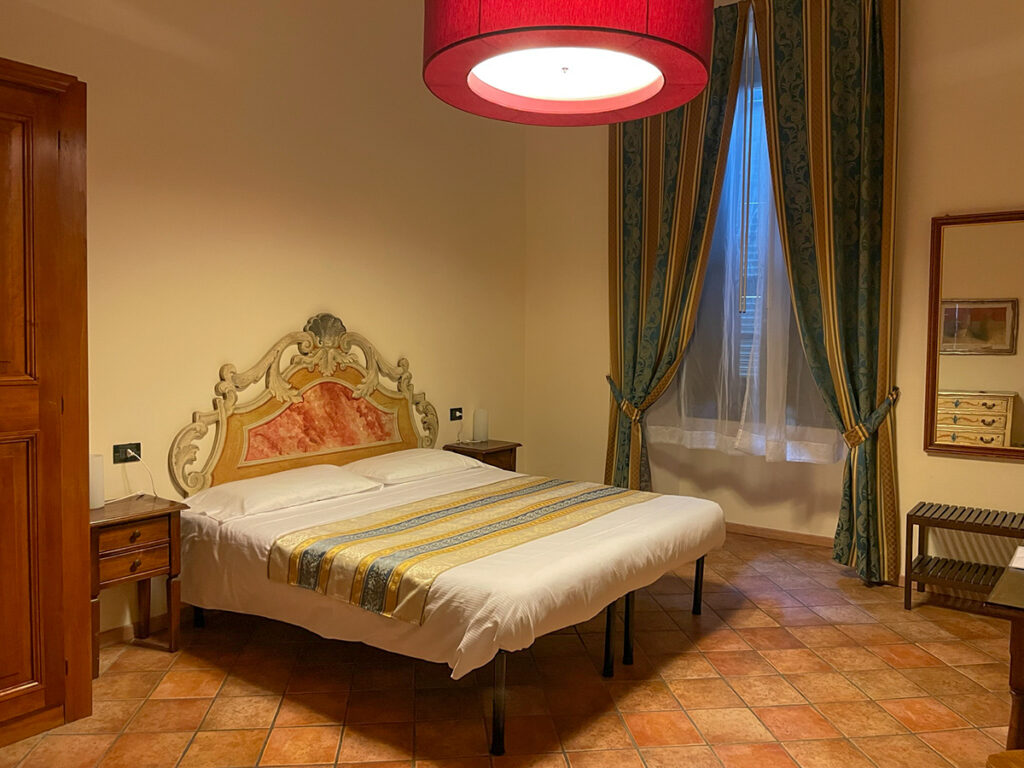
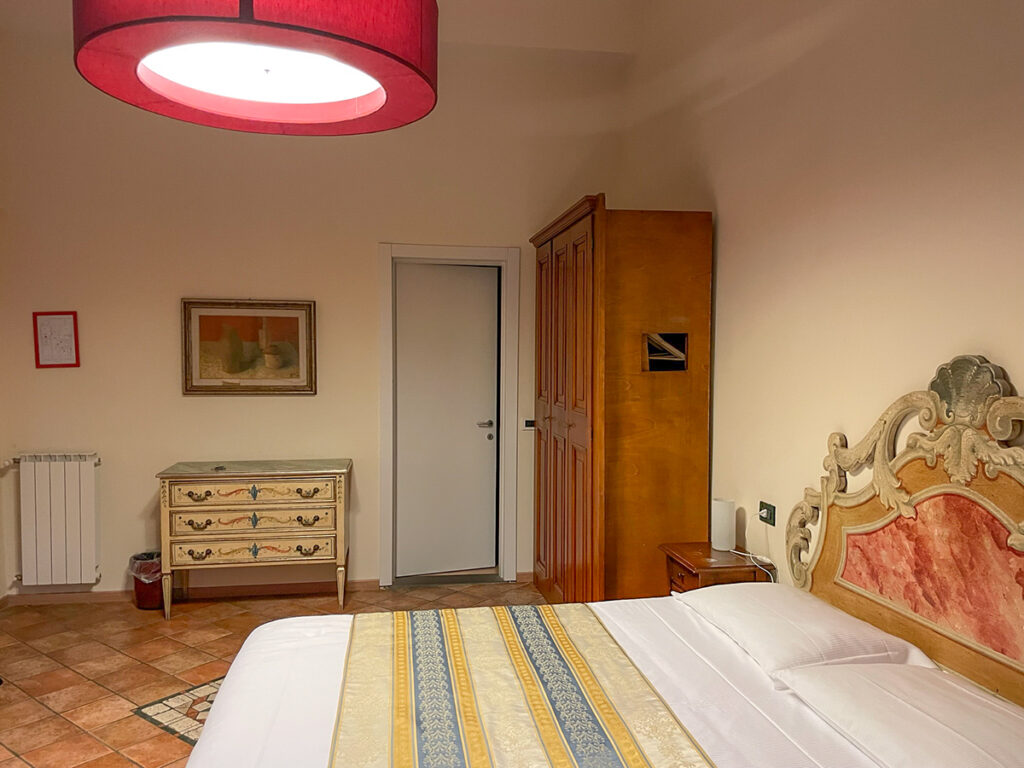
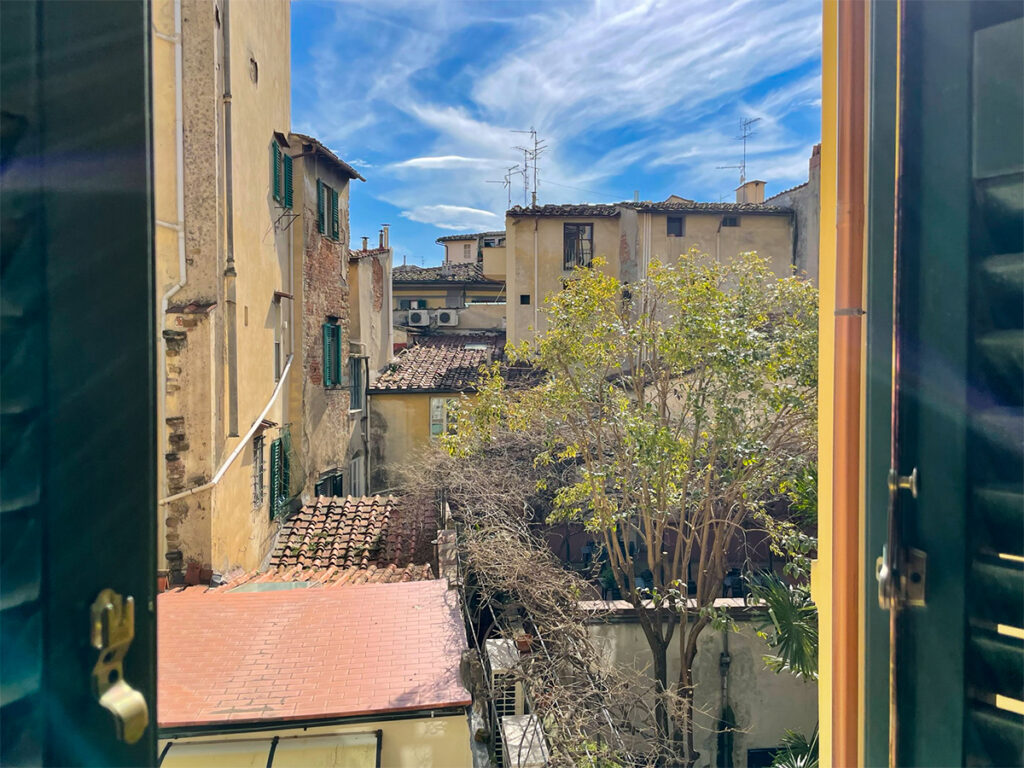
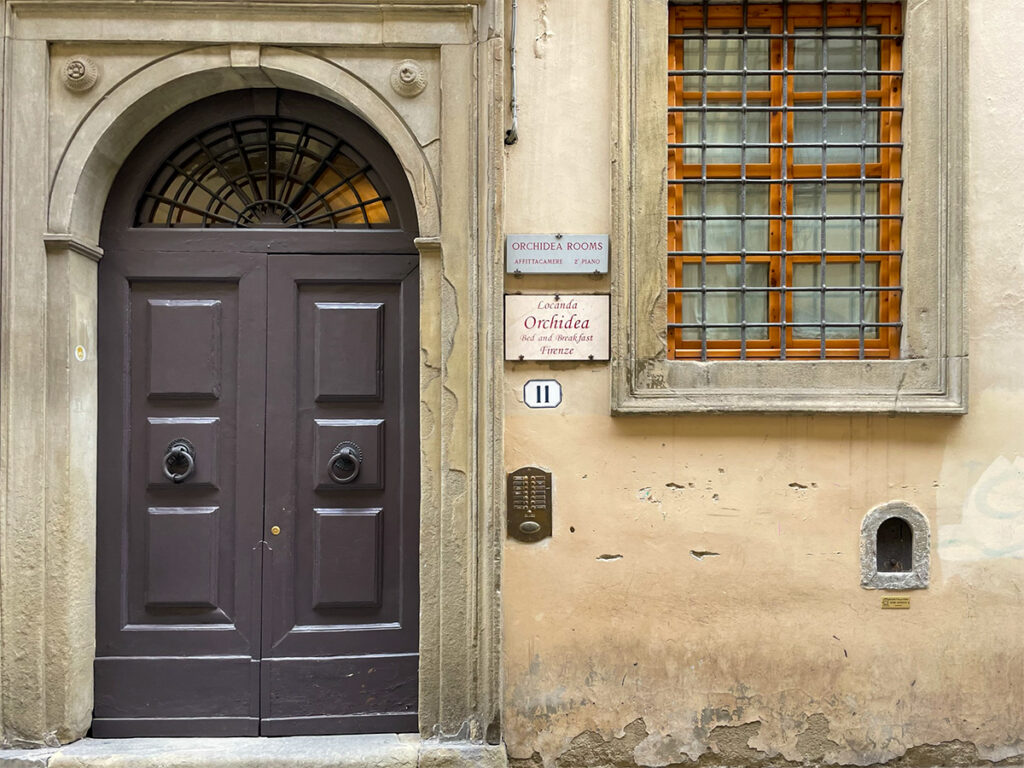
All the important things are taken care of: a comfortable bed, a good modern shower with fluffy white towels, a blow drier and toiletries, a mini fridge and a kettle. The cleaning service left the room smelling of flowers every morning, and the automatic heating kept the room cozy and warm.
Breakfast was a delicious spread of hot bread rolls and croissants, a selection of cold meats and cheese, sweet pastries, cereal, yoghurts, juice and coffee. And the statue of Dante Alighieri in the entrance hall always reminded me of the palace’s long history.
More on Exploring Italy
- Renaissance Cats in Florence – A Feline Lovers Guide to Florentine Renaissance Art
- 3 Days in Florence – Exploring the Cradle of the Renaissance
- 2 Days in Florence: Detailed and Flexible Itinerary & Tips
- 1 Day in Florence Itinerary – the Best of the Italian Renaissance
- Things to Do in Florence in Winter and Why Visit in Winter
- Leonardo da Vinci in Florence: In the Footsteps of the Renaissance Master
- Guide to Visiting Palazzo Vecchio: Must-see Art and Hidden Gems
- Medici Florence – a Self-Guided Walk in the Cradle of the Renaissance
- 18 Weekend Breaks in Italy: Top Destinations to Visit and Things to Do
- Quo Vadis – Assisi B&B Where Comfort Meets Medieval Charm

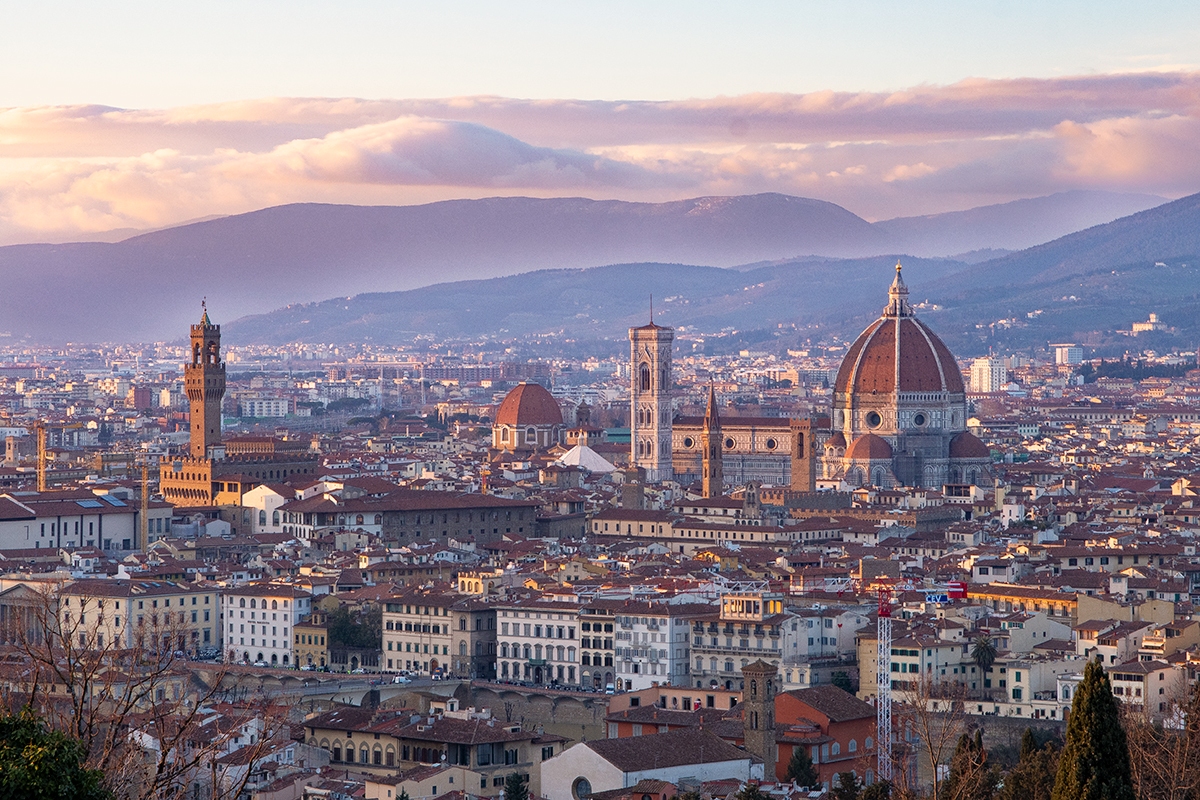
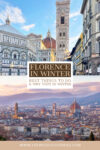
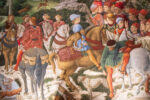
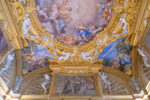
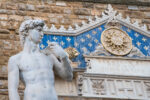
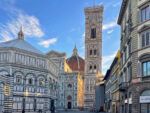
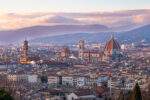
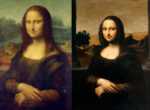

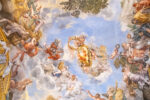
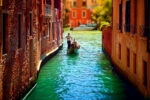
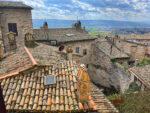
I stayed in Florence in July so I was so hot. A visit in the winter sounds sublime. Plus your B&B is gorgeous. Thankfully there are so many museums and churches to visit so you didn’t have to freeze.
We’re off to Florence tomorrow and so excited !!
It still looks pretty sunny in winter. I’d definitely consider coming to Florence in winter if it beats the crowds.
I dropped Florence when I had to prioritise my Italy itinerary (it’s years now). Still a bit sad about it, but maybe there will be opportunity to return.
I lived in Florence for a year and I couldn’t agree with you more! Florence is truly beautiful all year round, but the architecture truly shines during winter!
Love the cheeky street signs! I have fond memories of my visits to Florence in the summer and then the fall. There is so much to see and do and enjoy.
I have not yet visited Florence but it is high on my list. It looks so beautiful, and I definitely love the idea of visiting in winter. Fewer crowds and less oppressive weather sounds perfect!
I couldn’t agree more with your post about experiencing the enchanting beauty of Florence in winter. While many people tend to visit this mesmerizing city during the warmer months, they often overlook the unique appeal and charm it holds during the winter season.